- The Ultimate Guide to Anchor Charts and How You Can Use Them »

The Ultimate Guide to Anchor Charts and How You Can Use Them

Ever feel like you and your students are all over the place during a lesson? If that’s the case, an anchor chart can help because it keeps everyone’s attention in one spot.
An anchor chart is a helpful tool for teaching in all grades. It assists with lesson plans, gets students more involved, and gives extra details about classroom procedures.
Whether you’re a new teacher looking to boost student learning or an experienced one wanting something fresh in your classroom, an anchor chart is a great choice.
In this article, we’ll talk about what exactly an anchor chart is and ways it can make your classroom a better place for everyone.
Quick Links
What are Anchor Charts?
Anchor charts are like helpful posters in the classroom that show important information visually. They can be one big chart for the whole class or smaller ones in students’ notebooks. These charts are super flexible and easy to use, especially for students who find some things challenging or have different ways of learning.
Anchor charts can make learning more enjoyable as they are more interactive than just a regular list. Teachers can make a special anchor chart for a particular lesson and put it up where everyone can see it, like on a bulletin board or whiteboard. You want to put it in a spot that’s easy for students to check whenever they need.
Teachers all over the world really like and use anchor charts. They use them in classrooms for lots of different subjects. Let’s explore how using an anchor chart in your classroom can be really helpful.
Benefits of Anchor Charts
Guides students to work better.
Sometimes, students find it tricky to work by themselves or in small groups. It might be because they struggle to stay focused or don’t fully understand the lesson. Anchor charts can be a great fix for these challenges. Teachers often use anchor charts to explain what students should do when working alone. These charts guide students through their independent work. For example, in an English class doing close reading, an anchor chart can remind students of important reading strategies when they feel stuck.
You can also make use of their visual appeal to serve as a constant cue during tasks such as reading or engaging in writing exercises. The chart, with helpful info on things like phonics or basic grammar, can save teachers from answering easy questions by jogging students’ memories.
Makes Lessons Fun and Memorable
If you’re teaching about something that’s easy to show with pictures, make an anchor chart! For example, if you’re teaching plants, draw a big flower and point out all its parts as you talk about them.
Provides Practice
To really remember new ideas, students need to see them more than once. Some studies say it takes 7 or more times of seeing or practicing a concept to remember it for a long time. By keeping the anchor charts up in your classroom for the whole week (or even longer), students get more chances to see and remember the information.
Aids in Classroom Management
Anchor charts can help with managing your classroom, especially in the earlier grades. While it might not be as useful in middle school, it works well for elementary school and younger kids.
Since anchor charts use pictures, they’re perfect for little learners who are still learning to read. They act like reminders for rules and steps before the teacher can write them down. A good example is a chart showing the “Do’s” and “Don’ts” for active listening.
Helps to Recap Lessons
You can use the anchor charts as a starting point for your next lesson. Quickly going over what was covered in the previous day’s or last lesson’s anchor chart at the beginning of your new lesson helps students remember what they learned. You must start your lessons with phrases like “yesterday we learned…” or “if we think back to…”. This gives students a chance to refresh their memories and connect different lessons.
Facilitates Student Engagement
Getting students interested is really important when trying out a new teaching method . Making sure your class is actively involved in a lesson helps them really understand the material. You can use anchor charts in a fun way to increase student involvement.
One way to do this is to ask a question or give them something to think about, then have them write their answers on a sticky note. They can then stick the note on the anchor chart. When your students are actively taking part in these activities, you can see if they really understand the topic.
Improves Understanding With Visuals
Anchor charts are like visual guides that make tricky ideas easier to grasp. They show important skills and concepts in a clear and visual way. This helps students remember the information better because they can see how different parts connect. For instance, a chart about story elements can break down the different pieces of a story, making it simpler for students to get the idea.
Serves as Quick References
You can also use anchor charts to make helpful reference materials for your classroom. If students find a concept tough, you can create a cheat sheet that they can quickly look at when needed. For example, in math, it might be important formulas. In English, it could be new words. And in art, you might have a chart showing how colours mix to create different ones.
Develops Critical Thinking Skills
In the classroom, anchor charts also help students think better by making them analyse and put together information. This is because these charts often ask students to find connections between different things and see how information fits together. When students do this, they get better at looking at information and understanding it, which is a big part of thinking critically .
Helps to Stay on Track
When we’re teaching, it’s easy to go off track and talk about one thing, ending up with something completely different. Personally, you might begin with concept A and end up with concept C. Anchor charts help you stay focused and set yourself up for success right from the start of our lesson. When you gather your students for lessons (for both reading and math), a brief look at the anchor chart tells them what they’ll be learning in that lesson. It gives them a goal for the lesson and helps them stay on track.
How to Create Anchor Chart Ideas?
Have an objective.
Begin by figuring out what you want your students to learn. What’s the main thing you want them to get from your lesson or unit? Often, this goal will match a standard or a specific skill. For instance, if your focus is on understanding the beginning, middle, and end of a story, that becomes your goal.
You can also create charts that highlight classroom rules and expectations. We usually make these at the beginning of the school year , and they stay on display all year. If you see that students are forgetting a rule, you can point to the chart to remind them.
Create a Visual Plan
Outline or frame your chart to make it visually appealing. This is a simple step that you can do in advance. Get some markers because they have vibrant colours and a great smell! This visual framing helps direct attention to the key points inside the anchor chart.
Title and Headings
Planning titles and headings for your anchor chart can be done in advance. You can write them out or have them pre-printed and ready to use. Personally, a lot of people prefer having them printed in bright colours, which makes them stand out. If you laminate them, you can use them for other anchor charts later in the year.
Be Creative and Get it Done
- Add color and words. Use different colours and bullet points to help students see the different strategies easily.
- Keep it simple and clean. Use easy-to-read graphics and organize information clearly. Avoid distracting details or extra marks, like arrows or too much underlining.
- Draw simple pictures with the words. Complement words with simple drawings. The more ways students can learn about a topic, the better.
- Use them wisely. While anchor charts are helpful, you don’t need one for every lesson. Choose carefully to make a bigger impact.
- Feel free to borrow ideas. Teachers often get great ideas from each other. If your colleague has already made a chart on a topic, use the same style. Just be sure to create your own version.
Student Feedback & Improve
This step is super important! When your students join in, it makes the objective really stick. They should help you make the main part of the anchor chart. It’s a great way to get them interested!
There are different ways to do this. One way is to write down exactly what your students say on the anchor chart. Basically, they’re telling you what to write. Another way is to use Post-it notes, which we like. Post-it notes come in lots of sizes now, so you can write something down and then stick it on the chart. Even better, let your students do this!
The main idea here is to get your students involved. If they help make the anchor chart, they’ll feel a connection to the objective. They can look back at it if they need to and are more likely to remember what the chart is all about.
Right Placement
After you finish making your anchor chart, put it up in a spot where your students can see it easily and go back to it whenever they need it.
Popular Anchor Chart Types and Examples:
Interactive anchor chart:.
An interactive anchor chart is something students work on during a lesson. It’s a way for them to share what they’ve learned. These charts are made so they can be used many times in a unit.
For instance, if the lesson is about finding the main idea and supporting details, the anchor chart might have a diagram where students can stick post-it notes with the main idea and details from a class reading.
Procedural Anchor Charts:
Procedural anchor charts are there to help with classroom routines. They show how to do things like use an MP3 player at a listening centre or borrow a book from the classroom library. These charts might stay up for a longer time than other charts because they help with everyday tasks.
Vocabulary Anchor Charts
This type of chart focuses on important words in a subject. It usually has pictures, meanings, and details to help students understand and use the words in their learning and when talking about school stuff.
Strategy Charts
Strategy charts are common in classrooms and give students steps and strategies to follow for assigned tasks. They’re designed to help students by breaking down the process into steps. Strategy anchor charts often include examples done together in class, as well as tools like graphic organisers or acronyms that students learned during the lesson.
Classroom Procedure Charts
These charts remind students about the rules and expectations in the classroom, covering routines and procedures. They might also show how student work should be organised or completed before turning it in. Teachers often design anchor charts to clarify guidelines for note-taking or incorporating headings into assignments. The goal is to make it simple for students to organise their work and materials in a way that helps them successfully complete their tasks in the classroom.
Content Anchor Charts
Content anchor charts show important information about a topic. They help students remember key details and concepts. For example, if students are learning about animals, a content anchor chart might have important facts about different types of animals.
Background Knowledge Anchor Charts
Background knowledge anchor charts help students connect what they already know to new information. These charts remind them of what they’ve learned before and how it relates to the current lesson. It’s like building on what they already understand.
Articles Anchor Charts
Articles anchor charts provide guidance on understanding and working with articles, like in reading comprehension. They may include tips on finding main ideas, understanding details, or summarising information from articles.
Graph Anchor Charts
Graph anchor charts help students read and interpret graphs. They break down the different parts of a graph and explain how to gather information from it. These charts make it easier for students to understand and analyse data visually.
Diagram Anchor Charts
Diagram anchor charts show how to read and understand diagrams. Whether it’s a diagram in science or a map, these charts help students grasp the visual representation and extract meaningful information from it. They provide a step-by-step guide for interpreting diagrams effectively.
Why use anchor charts?
When is an anchor chart necessary, when are anchor charts made, what to do with an anchor chart after a lesson, how long should an anchor chart stay on the wall.
Last Updated on May 13, 2024

More Recent Blogs

From Kota to Your Classroom: Bridging the Gap...
A common question that many JEE and NEET aspirants grapple with is whether heading to […]

What Is a Learning Management System & How...
To make learning new things easier and speed up how we deliver well-organised training, companies […]

Augmented Reality In Education & Its Benefits
Learning techniques have come a long way since the traditional blackboard classroom methods. Now, technology […]
Leave a Reply Cancel reply
Save my name, email, and website in this browser for the next time I comment.

Found the blog insightful?
Get such ed tech insights delivered weekly to your inbox, for free. Subscribe to our newsletter.
- Teaching App
- Live Classes
- Learning App
- School Solutions
- STAR Program
- NCERT Solutions for Class 12
- NCERT Solutions for Class 11
- Solved Board Paper CBSE
- Solved Board Paper ICSE
- CBSE Class 12
- CBSE Class 11
- CBSE Class 10
- ICSE Class 12
- Sample Paper CBSE
- Exam Weightage CBSE
- CBSE Class 12 Solution
- Terms of Use

Anchor Charts to Improve Writing Skills
WHAT ARE ANCHOR CHARTS?
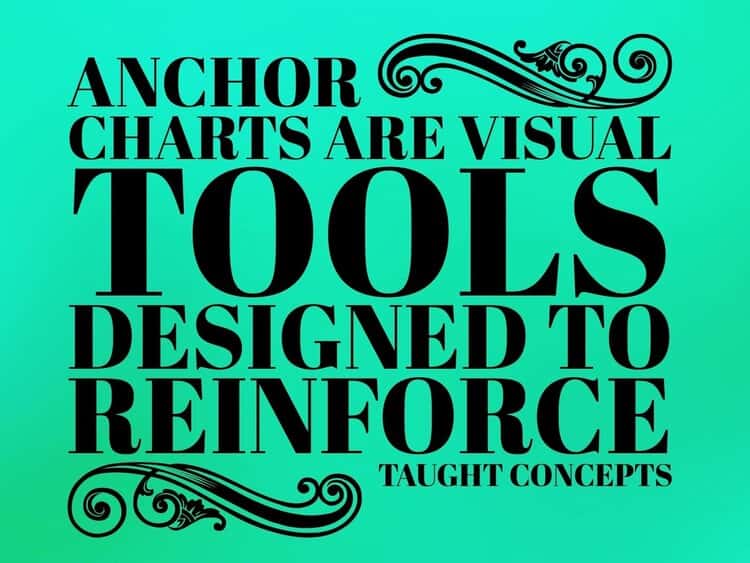
Anchor charts are tools that support learning in the classroom. They can be used to support everything from classroom management strategies to the teaching of writing.
Essentially, they are visual prompts that provide students with information regarding their prior learning on a given topic. These visual prompts are used to provide a scaffold to support the students during guided practice and independent work.
WHAT ARE THE BENEFITS OF ANCHOR CHARTS FOR WRITING AND READING?
Anchor charts are becoming increasingly popular in classrooms for some very good reasons. They offer a wealth of benefits for students and teachers alike.
Here are just a few of the great benefits of using anchor charts as writing tools in the classroom.
Anchor Charts Provide Increased Student Engagement
Anchor charts are an effective way of encouraging student engagement. Not only do they increase student confidence when engaged in a writing task, but they help to keep students on task by offering support in the form of visual prompts that help unstick the stuck! These anchor chart examples below provide students with a great visual point of reference to learn from.

101 DIGITAL & PRINT GRAPHIC ORGANIZERS FOR ALL CURRICULUM AREAS

Introduce your students to 21st-century learning with this GROWING BUNDLE OF 101 EDITABLE & PRINTABLE GRAPHIC ORGANIZERS. ✌ NO PREP REQUIRED!!! ✌ Go paperless, and let your students express their knowledge and creativity through the power of technology and collaboration inside and outside the classroom with ease.
Whilst you don’t have to have a 1:1 or BYOD classroom to benefit from this bundle, it has been purpose-built to deliver through platforms such as ✔ GOOGLE CLASSROOM, ✔ OFFICE 365, ✔ or any CLOUD-BASED LEARNING PLATFORM.
Anchor Charts Deepen Comprehension
Often, students get involved in the actual production of the anchor charts themselves. When helping to produce the anchor charts, students will have opportunities to reconstruct their learning and thereby deepen their comprehension of the material in the process.
As they construct their charts, students begin to make new connections between the various aspects of their learning as they organize these aspects in a visually comprehensible manner.
Anchor Charts Supports Independent Work
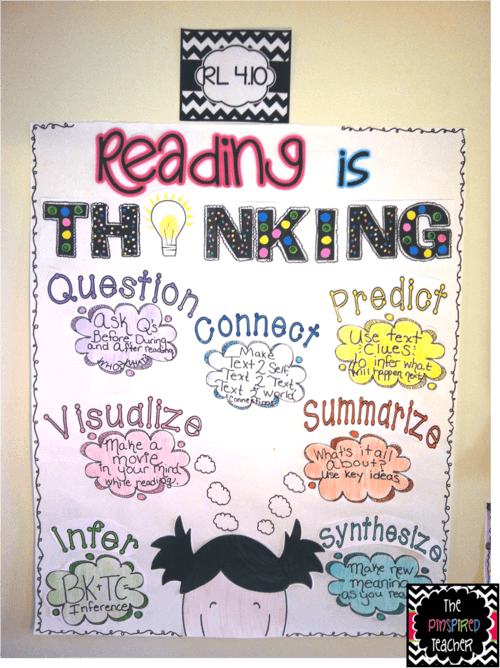
Learning to write well can be one of the most challenging things a student learns to do at school.
As students learn to navigate the demands of various writing genres , seemingly endless questions arise at word, sentence, and whole text level.
This, in turn, makes heavy demands on the teacher’s time as individual students struggle with the various challenges of a given task.
Fortunately, anchor charts can help alleviate some of that burden by providing a visual resource and reference point that help students to answer many of the more commonly asked questions for themselves. This frees up the teacher from having to repeatedly answer the same questions throughout the course of a lesson, making more time to offer support where it’s most needed.
WHAT DO ANCHOR CHARTS LOOK LIKE?

Anchor charts come in all shapes and sizes and can be commercially bought or produced collaboratively by students and teachers in class.
Commercially bought Anchor Charts are great for permanent displays within the classroom.
Usually well-presented in bold lettering using dynamic colors, professionally-produced charts work well for topics that recur throughout the course of the year and are complex enough to require ongoing reinforcement.
When anchor charts are self-produced, they are usually handwritten in large print and displayed in a prominent position in the classroom for easy reference.
Usually, a co-creation between the student and the teacher, the charts should contain only the essential information regarding the topic.
When deciding what to include on a chart, think about the concepts, strategies, and prior learning that will most help students to work independently when engaged in their work.
HOW ARE ANCHOR CHARTS CREATED IN THE CLASSROOM?
To produce an anchor chart in the classroom requires very little in the way of resources other than some chart paper and some colored markers. Other than these, and defining a clear purpose and focus for your anchor chart, there is no specific preparation required.
However, there are a number of common elements to consider when producing anchor charts for use in the classroom. Some of these include:
● Paper: Decide whether you are using adhesive paper, lined paper, blank paper, colored paper etc
● Font-Size: This should be large enough to see from the various working areas of the classroom
● Collaboration: Is it teacher-produced or a collaboration? What is the level of student involvement?
Where Anchor Charts are to be co-created with students, generally, they will be produced in collaboration with the students as you teach the lesson.
The chart will include the most important content and relevant strategies. In the case of the various writing genres, a list of the main criteria that must be included works well.
The anchor charts can then be used by the students as a checklist to refer to as the writing is produced. They can also serve for a final check when the work has been completed.
Here are some general tips to help ensure you get the most out of Anchor Charts in your classroom:
● Keep things simple
● Be sure the writing is well organised and easy to read
● Use headings and bullet points to help display the main points
● Use different colors for headings, bullet points etc
● Use simple pictures, graphs, illustrations etc to help reinforce points
● Don’t fill with lots of distracting details or graphics
Anchor Charts as Writing Tools – Examples

Anchor charts can be used very effectively to break down many of the more complex aspects of writing.
From punctuation use to the specific criteria for various writing genres, Anchor charts are a fantastic way to visually reinforce student understanding of these diverse processes.
The content of each chart will be dependent on their focus. But, let’s look at the possible content of two examples of Anchor Charts to help serve as models for what might be contained in an anchor chart produced in your classroom.
1. Point of View Anchor Chart
The Point of View Anchor Chart can be used both to help guide students in identifying the point of view in a text as well as to help in the creation of the student’s own texts. We have an excellent guide on point of view that can be found here.
Looking out for keywords is an effective way to determine the point of view in a piece of writing. Point-of-view keywords are generally centred around the pronouns and the level of insight and perspective we are offered.
Let’s look at some of the more common points of view used, first in a little detail and then at how they might appear on an Anchor Chart.
First Person – a character is telling the story (narrator), and we often gain insight into the characters’ thoughts. Clues that indicate a first person will be the use of pronouns such as I , my , me , mine , we , us etc.
As bullet points, this might look like this:
● First Person
○ Character narrates the story
○ Narrator is in the story
○ Narrator’s thoughts are revealed
○ Uses pronouns: I , my , me , mine , we , us etc.
Third Person Limited – the narrator is outside the story and telling the story. In third-person limited, the writer sticks closely to the point of view of a single character, so we are usually only privy to that one character’s thoughts and experiences. The narrator does not know everything about the events that occur in the story. Indications that the third person is being used may be the use of characters’ names and pronouns, such as he , him , his , himself , she, her , hers , herself , it , its , itself , they , them , their , theirs , and themselves .
● Third Person Limited
○ Narrator is outside the story
○ Narrator tells the story primarily from one character’s POV
○ Only the main character’s thoughts and feelings are revealed
○ Narrator has limited knowledge of events
○ Uses pronouns: he , him , his , himself , she, her , hers , herself , it , its , itself , they , them , their , theirs , and themselves .

Third Person Omniscient – the narrator tells the story and is privy to everything. Not only all the details of every event in the story, but the interior life of each character, such as emotions, opinions, and feelings, whether expressed or not. The usual third-person pronouns are used along with the character names.
● Third Person Omniscient
○ Narrator tells the story from ‘above.’
○ Narrator knows the thoughts and feelings of every character
○ Narrator knows everything that happens
2. Instructional Writing Anchor Chart
The criteria for writing clear instructions can be very handily displayed as an anchor chart.
When writing a set of instructions, students can refer to the chart to help organize their writing. The same chart will also serve as a checklist for self-assessment at the end.
An instructional writing anchor chart may include information such as:
Instructional Writing:
● Includes an explanatory title, e.g. ‘How to…’
● Laid out in bullet points or numbered instructions
● Uses time connectives to organise, e.g. ‘first’, ‘then’, ‘finally’ etc.
● Uses imperatives to instruct the reader
● Use straightforward, functional language
● Supported by illustrations or diagrams
● Diagrams and illustrations contain captions
In Conclusion
As we can see, anchor charts can serve as useful writing tools that support the development of student writing skills in the classroom.
When displayed prominently in the classroom, they can help students efficiently bridge the gap between being emergent writers lacking in self-confidence to becoming self-assured, independent writers.
It is important to remember, too, that though anchor charts are great tools that support students, ultimately, the intent is for the students to internalize the knowledge and information they contain. So don’t allow them to become a permanent crutch!
USEFUL VIDEOS TO EXPLAIN ANCHOR CHARTS
Other great articles related to anchor charts for writing.
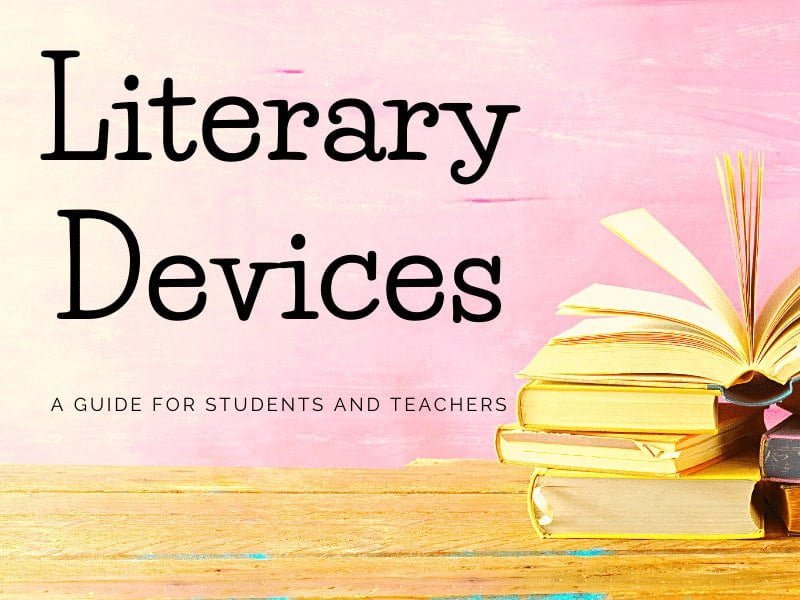
13 Literary Devices to Supercharge your Writing Skills
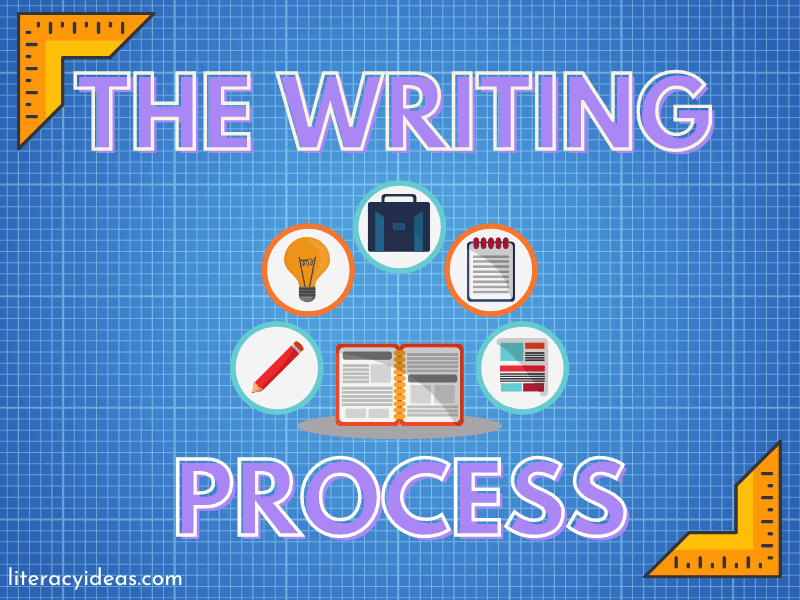
The Writing Process
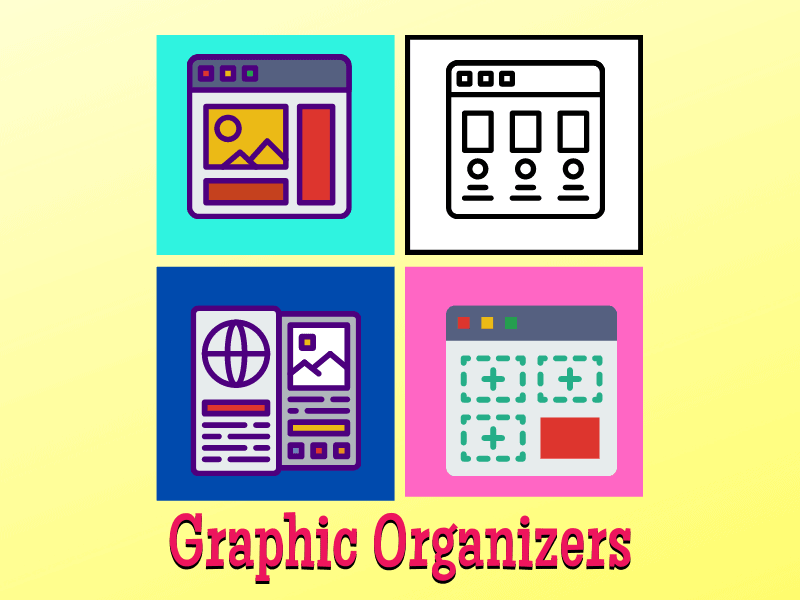
Graphic Organizers for Writing and Reading

Elements of Literature

Multiliteracies
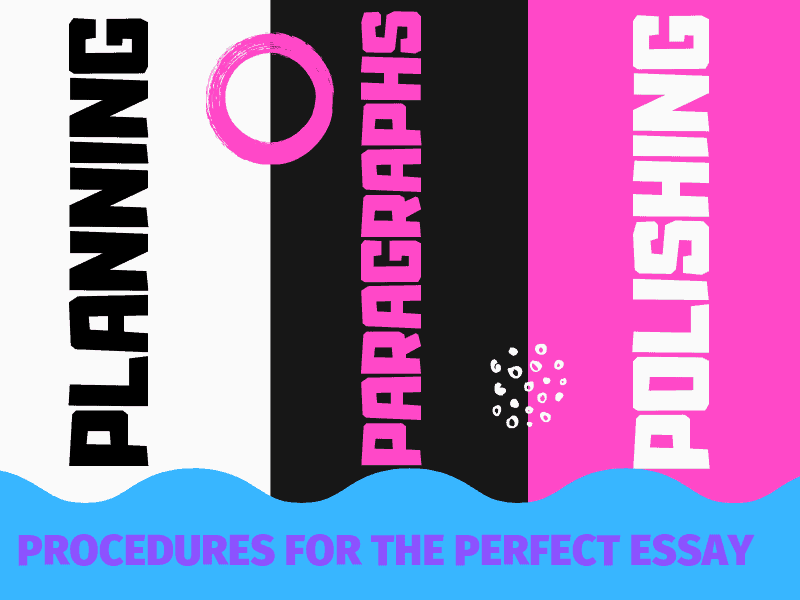
Essay Writing: A complete guide for students and teachers
Trending Post : Easy Fixes for Behavior Challenges

A Beginner’s Guide to Incredible Anchor Charts
If you’ve spent any time on Pinterest, you’ve likely been inundated with images of stunning classroom anchor charts. If you’re like me, you’ve probably scrolled through the eye-candy wondering how anyone has time to make these charts look so pretty and still cook dinner for their kids, grade papers, write lessons, do the laundry… you get my drift.
For many new teachers, the pressure to have a Pinterest-worthy classroom can feel overwhelming with all the other things being thrown your way. If this is you, don’t stress! Many first-year teachers walk into the classroom eager to take on the new challenge, but without much understanding of how best to get the most bang for their buck out of instructional tools, like anchor charts.
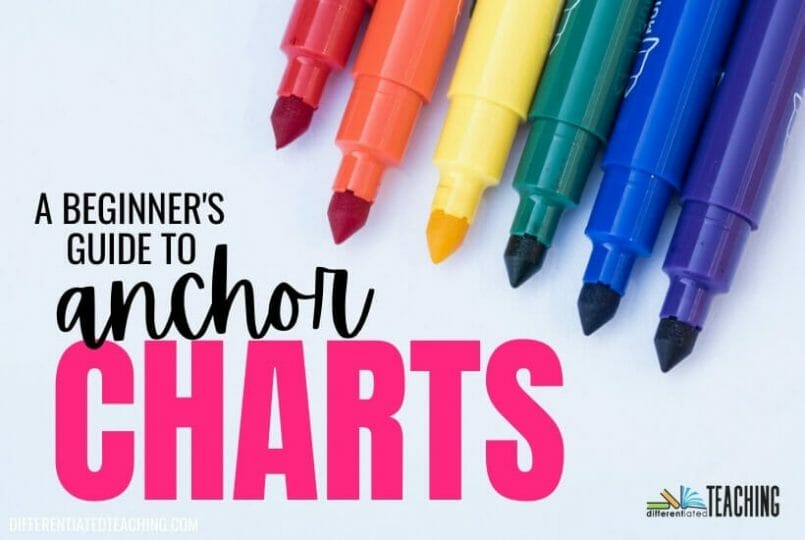
Today I wanted to share a little background information on what anchor charts are and how best to use them to support learning in your classroom. Whether you’re a brand new teacher or a returning veteran, I hope you’ll find some helpful tips and new information as you read.
This post may contain affiliate links.
What is an anchor chart?
An anchor chart is a teaching tool that helps visually capture important information from the lesson. They are created, at least in part, during instruction to help emphasize and reiterate important information, procedures, processes, or skills being taught.
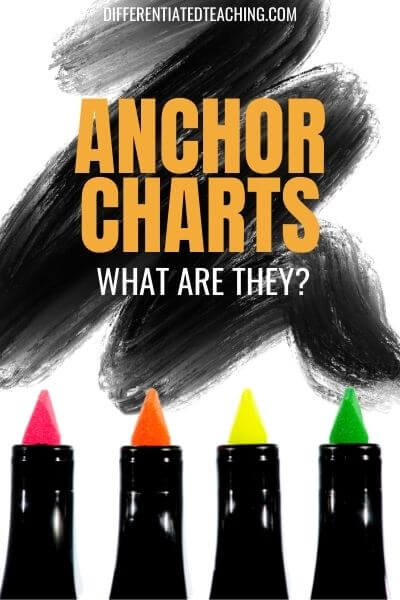
For example, if you’re teaching students a problem-solving strategy to help them approach multi-step word problems, your chart might include the steps in the process so that students can refer to this as they work through problems.
Some anchor charts are interactive, meaning that students help to fill them in as a part of the lesson by writing directly on the chart or using post-it notes. This can be a great tool for formatively assessing student understanding during instruction.
You can use anchor charts for any subject, and they are commonly seeing in reading , writing, and math classrooms. After the lesson, the chart should remain visible for students to refer to during independent practice and across future lessons.
Why are anchor charts valuable tools in the classroom?
Using anchor charts is a fantastic way to get students actively engaged in lessons. You can use these charts to teach vocabulary, explain concepts, illustrate examples, and make the learning process fun and visually engaging for students.
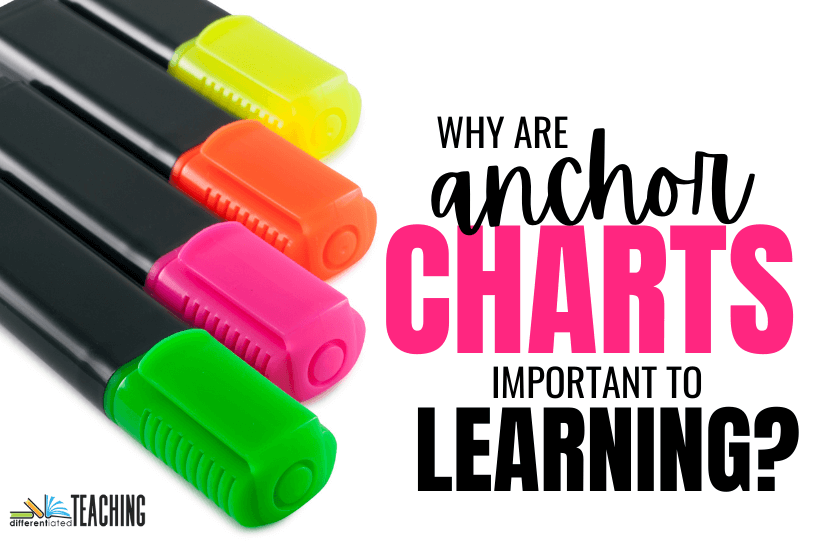
Anchor charts serve as a great scaffolded support in the classroom offering a visual reference that you and your students can look back at as you work through guided and independent practice.
While charts are great for all learners, they are especially helpful for several groups of at-risk learners. They offer students who struggle with attention a visual of the steps to guide them through a process. They can also offer English Language Learners a reference for vocabulary and key academic language .
You can also use charts to help students retain key information and make connections between prior knowledge and new information. Research shows this is a key to helping students build a stronger understanding of new material.
How To Make An Anchor Chart With Your Students
As you’re preparing to make a chart for your class, you’ll want to have a plan for what information you want to include and how you anticipate it being laid out prior to teaching the lesson.
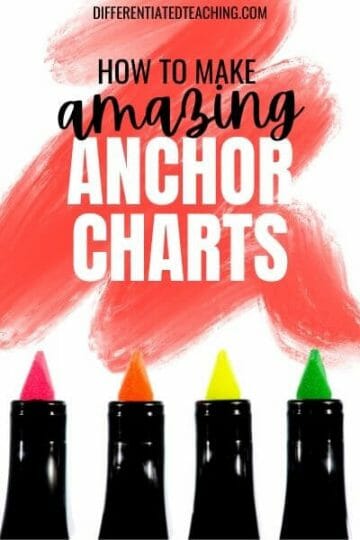
Since your students should be involved in the actual creation process (whether in a hands-on or verbal participation format), you don’t want to fully create the chart in advance.
However, that doesn’t mean you want to start class with a blank slate!
You can prep certain parts of your anchor chart – like headers, graphics, or questions you plan to have students respond to – in advance. This can allow you to focus on the instructional pieces more fully during the lesson instead of trying to get everything on the page while your students watch you write.
Here’s what you’ll need:
The great thing is that you don’t need a ton of supplies to make some really amazing anchor charts for your classroom. There are really only four things you’ll need:
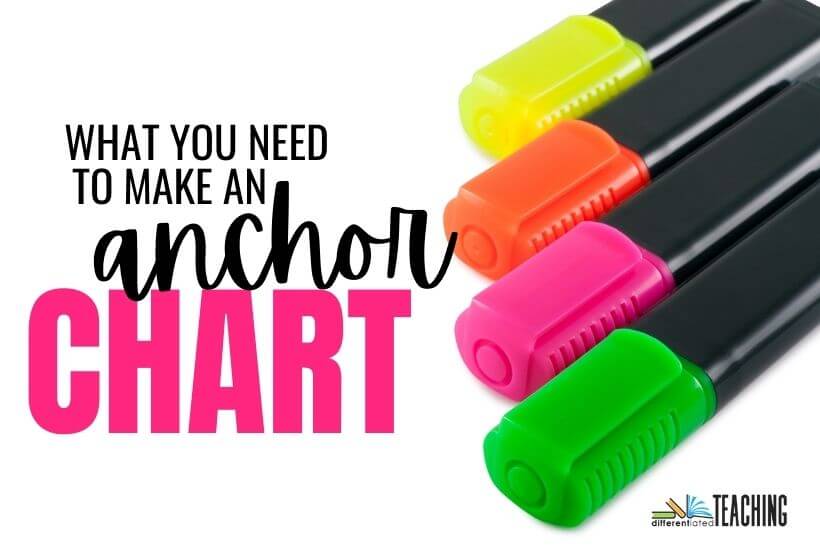
- Large chart paper – I love the Post-It Easel Tablets (affiliate link) because I can peel & stick.
- Markers – I prefer the wide Crayola markers & the Mr. Sketch markers (affiliate link)
- Projector (optional) – great for pulling up images to trace vs. trying to freehand graphics
During your mini-lesson, you can either record student responses or allow students to record their ideas on sticky notes to add to the anchor chart. You can also have students record answers directly onto the chart if you’re feeling really brave.
Okay, but how do you make an anchor chart pretty?
When you’re new to making anchor charts, the prospect of wanting everything perfect can be a bit overwhelming. First off, no one is expecting Pinterest-level perfection like some of the examples you’ll see below. This is especially true with interactive anchor charts, which are meant to be completed by the learners.
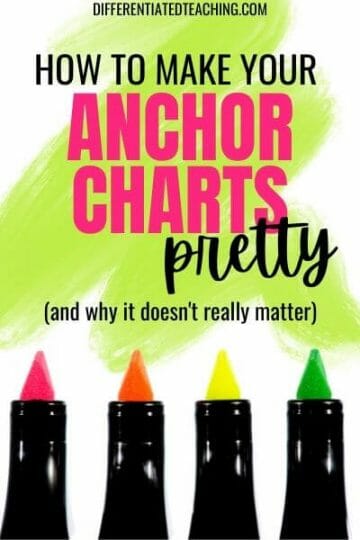
Here are a few simple tips to help keep things neat and organized while making your charts:
- Use your projector. Special fonts, graphics, etc can be displayed directly onto your chart paper as you prep your chart. Use a pencil to lightly trace the design to get you started.
- Start with a pencil. For charts that will be 100% teacher-written, create a light roadmap of where all the information will go. You can then write over this with a marker during the lesson as you complete each portion with your learners.
- Stick with simple. Trying to put too much information on a chart can create a huge mess. Focus on just the most important details and write big enough that the student furthest away from the chart can still refer to the information.
- Use Post-It notes for student responses. While you can have students write on the chart, you can use the same chart multiple years if you have students respond with sticky notes.
That being said, if your anchor chart doesn’t quite turn out how you hope it would during your lesson, you can always re-write it at a different time to make it pretty or more organized. However, I’d save your time and only do this if it is an anchor chart you plan to use consistently across time because your plate is already WAY too full.
How do you hang an anchor chart in the classroom?
This can be an issue depending on the types of walls you have in your classroom. Cinder block walls tend to be especially tricky. More than once I’ve come back to my room after a long weekend to find all my posters and anchor charts have fallen while the air conditioner was turned off.
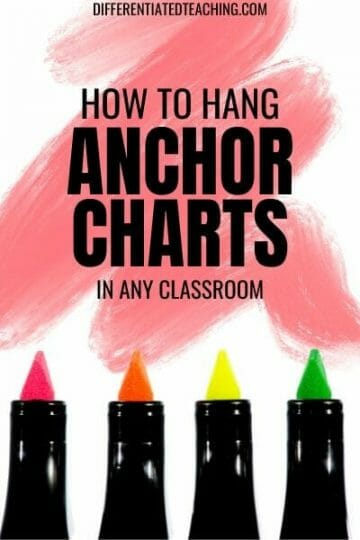
That being said there are several ways to display anchor charts that can help maximize their use. First, try to select an area that you’ll consistently use across time for each subject. That will help students develop a habit of referring to that area when they are seeking support or need to double-check for the information from the lesson.
Here are a few options for hanging your anchor charts:
Use a curtain rod. A thin curtain rod with two metal hooks can be a great way to display anchor charts. Add new charts to the ring across time for easy reference.
Try hooks. Command hooks and magnetic hooks can both be great options depending on your walls and board space. If you’re in a portable classroom, magnetic hooks can keep things really neat and easy to move when necessary.
Poster Frames can be a great choice, too. If you like things to look a little neater, cheap poster frames can be a great alternative. Just be sure to get the right size so they fit your chart paper correctly.
Use a pants hanger. You can easily clip the poster inside the pants hanger. Then hook it to the top of a whiteboard, on a cupboard, or on a nail. Most stores would be happy to give you one for free if you tell them you’re a teacher.
Use hot glue to help with cinder block walls. Hot glue clothes pins or hooks to your cinderblock walls. You can easily remove these later, but they won’t fall down like tape or the putty.
Dedicate bulletin board space by creating a focus board. Create a subject-based focus board that includes vocabulary, standards being covered, etc. Leave space to display your anchor charts after you create them. This creates a one-stop-shop for students when they need to reference something for more information.
The 4 Most Popular Types of Anchor Charts
While there are lots of different kinds of anchor charts out there, as Pinterest can plainly show us. Most anchor charts you’ll create for your classroom fall into one of four main categories. These four types are interactive charts, vocabulary charts, strategy charts, and procedures charts.
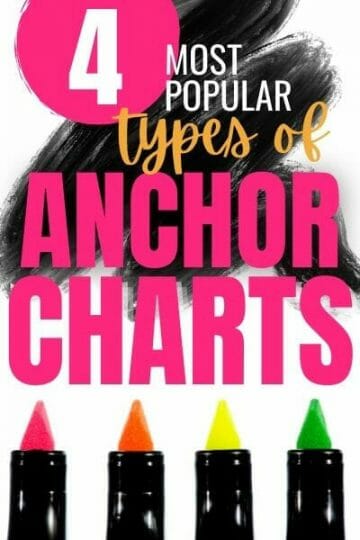
Here’s a little more information about each type.
1. Interactive Anchor Charts
Interactive anchor charts are designed to be completed as a part of the lesson process. They are a way of students showing their learning. These anchor charts are commonly designed in a way that they could be used multiple times within a unit.
For example, when teaching a skill like main idea and supporting details, the anchor chart might include the graphic organizer where students can add a main idea and supporting details using post-it notes from a reading the class did together.
Interactive anchor charts can be a great tool for formative assessment .
2. Vocabulary Anchor Charts
This type of chart focuses on content area vocabulary. It commonly includes visual examples, definitions, and details that can help the students apply the term to their learning and in academic conversation.
Here’s a great example:
3. Strategy Charts
This type of chart is common in classrooms. They provide the steps and strategies students can refer to when working through assigned tasks. Designed as a way to scaffold instruction, strategy anchor charts lay out the step-by-step process the student should go through to implement the material taught in the lesson.
This often includes worked examples done as guided practice and graphic organizers, acronyms, or other tools that students were taught to use during the mini-lesson time.
4. Classroom Procedure Charts
These charts remind students of the expectations in the classroom. This can include the routines and procedures of the classroom . It might also include how student work is expected to be structured or completed prior to being turned in.
Sometimes teachers create anchor charts to show expectations for notetaking or adding headings to assignments. The goal of these charts is to make it easier for students to organize their assignments and materials in a way that helps them successfully accomplish the classroom tasks.
The Positives & Negatives of Visual Supports
While the idea of creating a chart in front of your learners may make you shiver, anchor charts offer a number of important benefits for student learning.
Not only do they offer a visual that helps keep students engaged during the lesson, but they also provide help to facilitate self-directed learning. Instead of being reliant on the teacher to answer every question that arises, students can refer back to the anchor chart to clarify and reassure them that they are on the right track.
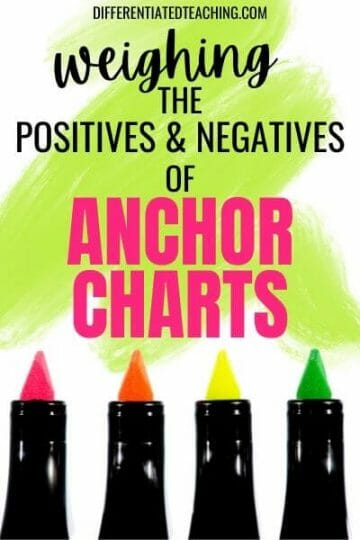
However, it is important to remember that there can be too much of a good thing. It is important to prioritize what information you’re putting onto a specific chart, but it is also important to prioritize how many charts are on display at any given time.
Too many visuals in the classroom can be a major disruption to learning. This means that instead of helping your struggling learners by providing visual cues on how to complete the task at hand, you might actually end up making the task more difficult because they’re being overwhelmed by too much visual stimuli.
Therefore, it’s important to find a balance. As a new teacher, you may feel pressure to make an anchor chart for everything. Take time to assess whether this is something that your students will use again and again. If not, feel free to let that pressure go!
Similar Posts

What to consider when your classroom management plan isn’t working
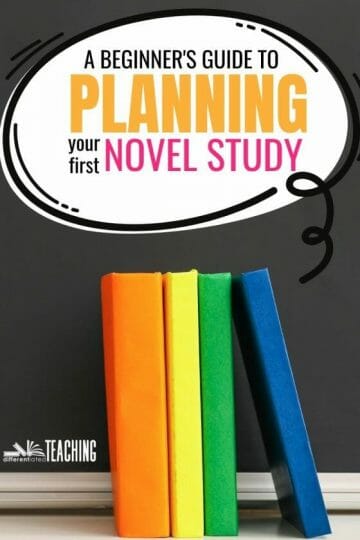
How to Plan a Novel Study Step-by-Step

How to Use a Math Spiral Review to Increase Achievement

Hatchet Novel Study Unit

Improving Personal Narratives with a Focus on Seed Stories

Differentiated Place Value Worksheets

Writing Workshop: Everything You Need To Know To Create an Anchor Chart
1. writing workshop: anchor charts 101, 2. everything you need to know to create an anchor chart for writing workshop, 3. writing workshop: everything you need to know to create an anchor chart.
“I don’t have room for all these anchor charts in my classroom.”
Does this sound familiar?
I often found myself repeating this over and over again as a classroom teacher. And then, I’d wonder:
What kind of anchor chart should I make? How can I elevate the level of my anchor charts? How long should I keep an anchor chart up?
Keep reading for the answers if you’ve ever asked yourself these questions.
Anchor charts are an essential tool used to support instruction.
As you teach, you use your anchor charts to capture strategies that students can refer back to during mini-lessons , small groups, and independent writing time . Anchor charts also help build a culture of literacy by making the thinking visible as well as supporting all different learners within your classroom (i.e., visual, auditory, ELLs).
Anchor charts are typically created in real-time with students during a mini-lesson. They can display both student and teacher thinking by including teacher and student writing samples.
Then, you can display them on the wall for students to refer back to. Make sure to update them throughout the school year. Read more below about the many different anchor charts you can create to enhance your teaching and student learning.
Types of Anchor Charts
1. Procedural Anchor Charts
Use procedural anchor charts to highlight routines and systems within your Writing Workshop block. You’ll likely introduce these charts at the beginning of the school year when launching the workshop. You can create a chart for each new routine or system you want to teach or revisit old ones that need extra practice throughout the school year. You can use the anchor chart in the image for primary grades (K-2) to establish a Writing Workshop set-up routine.

2. Writing Behaviors Charts
Writing behavior anchor charts highlight behaviors we want our writers to build into habits. As your writers become more sophisticated throughout the school year, you want to make sure that your behavior charts match the level of your writers. You can use the anchor chart below to help establish stamina. Students can visibly see their goal as well as their progress as they work on building their stamina.
EXPERT TIP: Once your students build a writing habit, you can retire the anchor chart.
3. Individual Strategy Charts
Individual strategy charts focus on a single writing strategy. They aim to break down the strategy into clear, bite-sized steps that you’ll model during the teach section of a mini-lesson. Each unit of study cycles through the writing process (generating, choosing/developing, planning, drafting, editing, revising/elaborating).
Along the way, you introduce your writers to different strategies within each part of the writing process. The right anchor chart focuses on the writing process’s generating portion. It introduces a single strategy students can use when generating ideas for a true story. While you teach using your anchor chart, it’s key that the words you use match what’s on the anchor chart. Example: Saying true stories on your chart but using the term ‘small moments’ while you demonstrate.

4. Menu of Strategies Charts
If you’re introducing several additional strategies within that same part of the writing process, you can build a menu of strategies anchor chart. Unlike a zoomed-in strategy chart, a menu of strategies chart has several methods to select from. These charts give students the power to make their own decisions as to which one they want to use in their writing. The anchor chart to the left has five different strategies that
students can choose from when generating ideas for a personal narrative.

EXPERT TIP: Once you’ve introduced a strategy to add to the menu chart, you can retire the individual strategy chart.
5. Process Charts
Process charts are an excellent way to set your students up for independence by supporting them in understanding where to go next in their writing. These types of charts highlight a certain part of the writing process within a genre and can be displayed throughout a unit of study.
EXPERT TIP: Make small samples of anchor charts for students to keep in their writing folders.
6. Characteristics of the Genre Charts
Genre charts highlight characteristics of a genre, such as topics, text features, structure, tone, and author’s purpose. You can make these charts during the immersion week when highlighting craft moves and techniques of a specific genre. The anchor chart to the right highlights the characteristics of narrative writing.

7. Exemplar Piece Charts
This chart is a key lever during immersion week. You can also create it with your writer’s input. It highlights the characteristics of a strong writing piece. The chart is a living, breathing document which students can revise as they learn more about the genre and develop their level of sophistication. The anchor chart below highlights certain characteristics of an informational writing piece, such as catchy subtitles, pictures, and captions.

EXPERT TIP: While students are editing and revising, it can be helpful to reintroduce this chart and remind them what they can approximate from other writers!
8. Checklists Charts
Editing checklist charts help students monitor their progress during the revision and editing process. Make copies so students can refer back to them in their folders. Often, students will be in different stages of the writing process, so it’s helpful to have something to reference. These charts can be revised as students learn more throughout the unit and learn more sophisticated skills.
Expert Tips for Effective Anchor Charts
There are many different ways to improve your anchor charts. Below are three ways you can elevate your anchor charts.
1. Add visuals: One way to raise the level of your charts and support your learners is to add visuals. This is essential for our primary readers and writers to be more independent when using charts. These visuals ideally match your teacher demonstration piece. For example, if you are writing about using a big feeling, such as being excited to generate small moments you can write about, include a visual of those feelings on the anchor chart. You can also include drawings, print out clipart, or add photographs of your student doing the steps or process.
2. Include examples from mentor texts: You can include examples from mentor texts that have already been introduced and read to your class. These examples can be photocopied and placed directly on the chart.

3. Include writing samples demonstrating the writing strategy: Writing samples can be either teacher or student created. These can be used on anchor charts to show a model example of the strategy.

Anchor Chart Maintenance
Anchor charts are most helpful when students see and use them! Make sure you have a designated place in your room to display your workshop charts. It’s useful when all writing charts are together in one area. When using anchor charts during Writing Workshop, make sure to display them in a clutter-free space in your gathering area.
Once you have introduced your chart during your mini-lesson, you should be referencing it consistently throughout and every time you state the teaching point. Following your mini-lesson, keep the anchor chart visible for all students to reference as they work independently. This also allows you to reference the charts while conferring, in small groups, and during partnership work. You can also refer to the chart at the end of the workshop during the teaching share.
Decide if you’ll display or retire the chart by surveying your writers. If you retire a chart and you have the space, keep it. If not, take a picture of it. If you continue to display the chart, place it in a clutter-free, prominent spot designated for workshop charts. You can create smaller versions for students to put in their folders or keep them at the writing center.
EXPERT TIP: A great way to know when to retire a chart is to survey your students and ask, “who uses this chart?” If a small number of students use the chart, you can make smaller individualized copies for those students and take down the original.
Whether you’re just getting started with creating anchor charts or have been doing them for a while, hopefully, some of these ideas might be helpful for you as you think about which type of anchor charts you can make, how to elevate your anchor charts, and how long you should keep an anchor chart up.
Keep exploring with these articles:
- Setting Up a Writing Center: 8 Basics
- The Writing Process for Primary Grades
- Supporting English Language Learners in Writing Workshop
Share this:
- Click to share on Twitter (Opens in new window)
- Click to share on Facebook (Opens in new window)
- Click to print (Opens in new window)
- Click to share on LinkedIn (Opens in new window)
- Click to share on Reddit (Opens in new window)
- Click to share on Tumblr (Opens in new window)
- Click to share on Pinterest (Opens in new window)
- Click to share on WhatsApp (Opens in new window)
Recent Blogs:

Our Top 10 Read Aloud Picks To Add To Your Library
I was supporting a school last month and had a chance to attend their book fair. A rush of nostalgia and excitement hit me all at once … THE BOOKS!!! Finding great titles to read to your students can be thrilling, but also… overwhelming. To help you out, we’ve pulled...

Keeping the Love of Literacy Alive During State Testing
It’s that time of the year again, state testing. I remember the pressure and the stress that would set in during this time. With schools emphasizing test preparation and students feeling the pressure to perform, it is easy for the love of literacy to get lost in the...

Writing About Reading: Lifting the Level of Reader’s Notebooks
Writing About Reading For many years, when I heard the word “jot,” my mind went straight to an explosion of sticky notes. I pictured post-its falling out of students’ books, littering the classroom floor, crumpled up in notebooks, book baggies, and bins. Hastily...

ADMINISTRATORS
Customized professional development that increases test scores and teacher retention while fostering a true love of reading and writing for your students.

Modern solutions for busy teachers who want to stay at the top of their game and nurture their passion for teaching.

AT HOME & IN YOUR COMMUNITY
Learn how you can be an advocate to strengthen literacy in your child’s school.
Related Blogs:

Take back your planning time with engaging, no-prep resources!
The Ultimate Guide to Anchor Charts
By MARISSA DESPINS Updated March 19, 2024
All About Anchor Charts
Are you curious about what anchor charts are and how you can use them to enhance classroom learning? You have come to the right place! Anchor charts are vibrant, visually engaging posters that are hung on the walls of the classroom. They not only beautify your classroom space but also serve as powerful learning tools. These handy charts display lessons, strategies, and key concepts in ways that are easily accessible to all students. Whether you’re a seasoned educator or just starting out, learning how to make and use anchor charts can transform your teaching and enhance student learning.
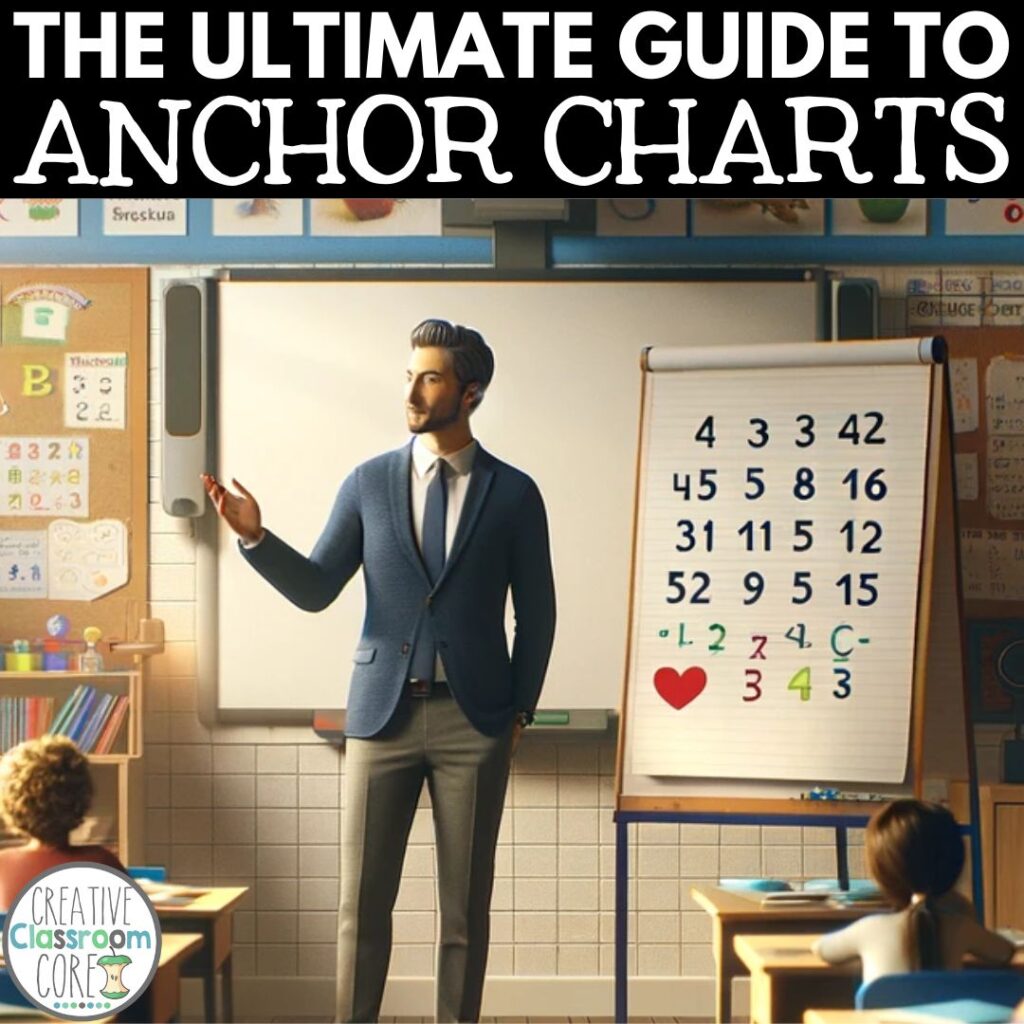
In this ultimate guide to anchor charts, we’ll explore everything you need to know to get started with using them in your classroom.
(This post contain affiliate links which means I make a small commission if you make a purchase, at no additional cost to you. Thank you for your support!)
What is the Purpose of an Anchor Chart?
Anchor charts serve as visual reference tools that support classroom instruction. The charts summarize and highlight key concepts, strategies, and processes discussed during lessons. After creation, students can look back to the chart to clarify their understanding or review information throughout the school day.
Part of what makes anchor charts are so effective is that they are co-created with students during the learning process. This helps to solidify understanding and allows students to actively participate in their own learning – and, as teachers, isn’t that one of our biggest goals?
How do you Make an Anchor Chart?
To make an anchor chart, you first need to gather materials. This will include chart paper and markers.
Next, you need to plan your content around a key lesson or concept you want your students to remember. Choose a layout that clearly and visually organizes the information, such as bullet points, diagrams, or mind maps. Using bright colors and bold letters for headings helps to draw attention to key points and details. Also, make sure the text is large enough to be read from anywhere in the room. The incorporation of symbols and drawings helps to make abstract ideas more concrete.

As you create the chart, it is important to remember to engage your students in the process. Co-creating the charts helps to make the learning more meaningful. It also ensures the chart reflects their understanding and questions. Each chart is a reference tool for students to use, and should include the information they need most.
Finally, place the finished anchor chart where it’s easily visible to all students. This collaborative and strategic approach makes anchor charts an effective tool for reinforcing learning and supporting student independence.
What is the Difference Between an Anchor Chart and a Poster?
While anchor charts and classroom posters share some similarities, there are key differences to keep in mind.
Anchor charts are teaching tools that are co-created with students during the learning process. They serve as “anchors” to reinforce student learning by capturing and displaying key concepts and strategies discussed in class. Anchor charts are not just decorations – they are meant to be referred to often, helping students recall and apply what they’ve learned independently.
Posters, on the other hand, are usually pre-made or teacher-created visual aids designed to decorate the classroom or provide information. They might contain inspirational quotes, subject-specific facts, rules, or student work. However, they are not typically created as part of an interactive learning process with students. Posters serve more as background material or supplemental information rather than as an active part of the day-to-day learning process.
How do you use them in the Classroom?
Interested in using these handy charts to help enhance teaching and learning? Follow these steps to help you successfully use anchor charts in your classroom!
- Create the Charts with Students : Involve students in the creation of the anchor charts you use in your classroom. This collaborative process helps solidify understanding. It helps make the charts more meaningful to students, as they are active participants in their own learning.
- Display Anchor Charts Strategically : Place anchor charts where students can easily see and refer to them. You don’t want to hide them away in a dark corner of the classroom. Students need to refer back to the charts often, so they should be easy for students to spot and use.
- Refer Back to the Charts Often : Regularly direct students’ attention back to relevant anchor charts during lessons or when they have questions. This reinforces their use as a learning tool.
- Encourage Interactive Learning : Use anchor charts interactively by having students add to them, use sticky notes for comments or questions, or reference them during group activities. I am yet to teach a lesson where a strategically used sticky notes has not brought instant engagement.
- Use the Charts to Review and Reflect : Periodically review anchor charts as a class to reinforce learning and assess understanding. This can also help identify areas that may need further review or instruction.
Reinforcing Key Skills in the Classroom
Follow these tips to help you use anchor charts in your classroom to reinforce key skills.
- Skill-focused Charts : Create anchor charts that are specifically designed around a key skill you want students to master, such as summarizing, inferencing, or problem-solving. Clearly outline steps, strategies, or processes students can follow. As these are key skills that you will use throughout the year, you can store the charts in your classroom to access when needed, saving you a lot of time.
- Visual Cues and Examples : Include clear, visual representations of concepts and skills on your charts, along with concrete examples. Pictures and diagrams can help make the information on the charts easier to understand and remember.
- Student Contributions : Allow students to add examples or tips to the anchor chart based on their experiences and successes. This allows students to be actively involved in the learning process, making things collaborative and personalized.
- Consistent Reference : Regularly point students back to the anchor charts when the related skill is being used or when a student asks a relevant question. This reinforces the idea that the chart is a tool, not just decoration.
- Skill Review Sessions : Dedicate some classroom time to review the anchor charts as a class. This helps to reinforce key skills and ensures that students feel comfortable using the charts as reference tools.
Anchor Chart Examples
Check out some great anchor chart examples below!

A Few Helpful Tips
To ensure anchor charts are used as effectively as possible in your classroom, consider these helpful tips:
- Keep the Charts Clear and Concise : Focus on the essential information to avoid overwhelming students. Use bullet points, numbers, or short sentences to make your points clear.
- Use Color Wisely : Colors can highlight important information and help organize thoughts. However, too much color can be distracting. Stick to a few complementary colors to make your chart visually appealing and easy to read.
- Include Visuals : Drawings, symbols, and icons can help students understand and remember concepts better than text alone. Use simple illustrations to reinforce the ideas on your chart.
- Make Your Charts Interactive : Involve students in creating and adding to the anchor charts. This can include everything from brainstorming ideas to drawing pictures, which increases their investment and engagement.
- Display Strategically : Place anchor charts where students can easily reference them during related activities or lessons.
- Refer to Them Often : Regularly direct students’ attention back to relevant anchor charts. This reinforces their value as a learning tool and helps solidify students’ understanding.
- Create with a Purpose : Before making an anchor chart, identify the key lesson or skill it will support. This focus ensures that the chart serves a specific, meaningful role in your classroom.
- Keep Things Flexible : Be prepared to update or modify your charts based on students’ needs and comprehension levels. Learning is dynamic, and so should be your anchor charts.
By incorporating these tips, your anchor charts can become incredibly effective teaching tools, enhancing learning and engagement in your classroom.
Looking for more Creative Ways to Enhance Classroom Learning?
Check out these posts below!
Character Analysis Activities for Middle School
Teaching Characterization with Bridge to Terabithia
Using the RACE Strategy in ELA
Interested in signing up for my email list?
If you are interested in signing up for my email list , you can do so by clicking on the link below. I periodically send out emails with free resources, teaching tips, and exclusive deals. Signing up will also give you immediate access to some of my best selling Interactive Notebook resources – foldable activities, graphic organizers, and other fun activities.

Similar Posts
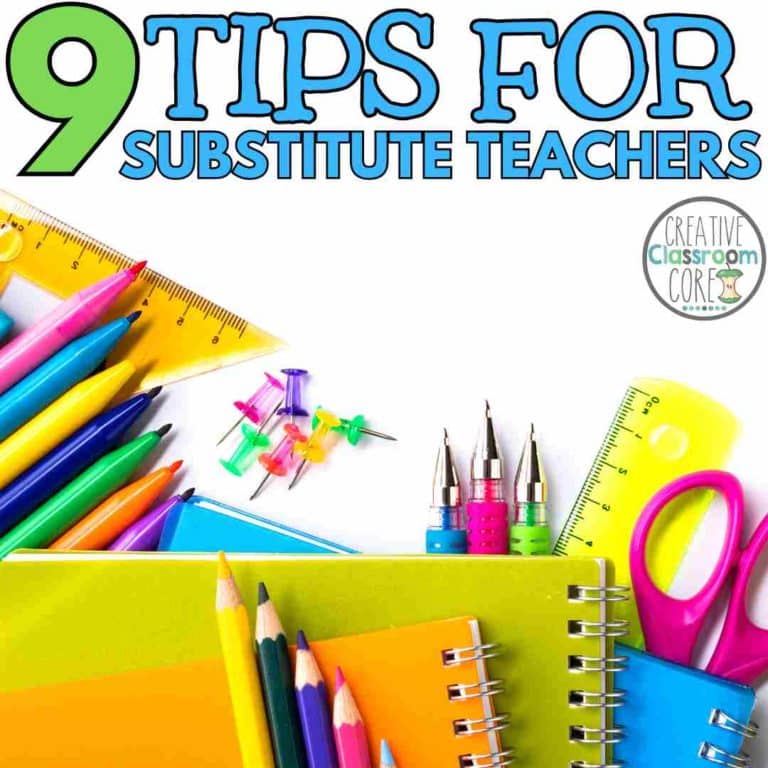
Tips for substitute teachers
By MARISSA DESPINS Updated Oct 4, 2023 Looking for tips for substitute teachers? Substitute teaching can be both rewarding and challenging. As a substitute teacher, you step into various classrooms and play…

Terry Fox Activities for Elementary
By MARISSA DESPINS Updated March 20, 2024 With September’s Terry Fox Run on the horizon, this is a perfect opportunity to spotlight this exceptional Canadian hero. To maximize our learning on the…
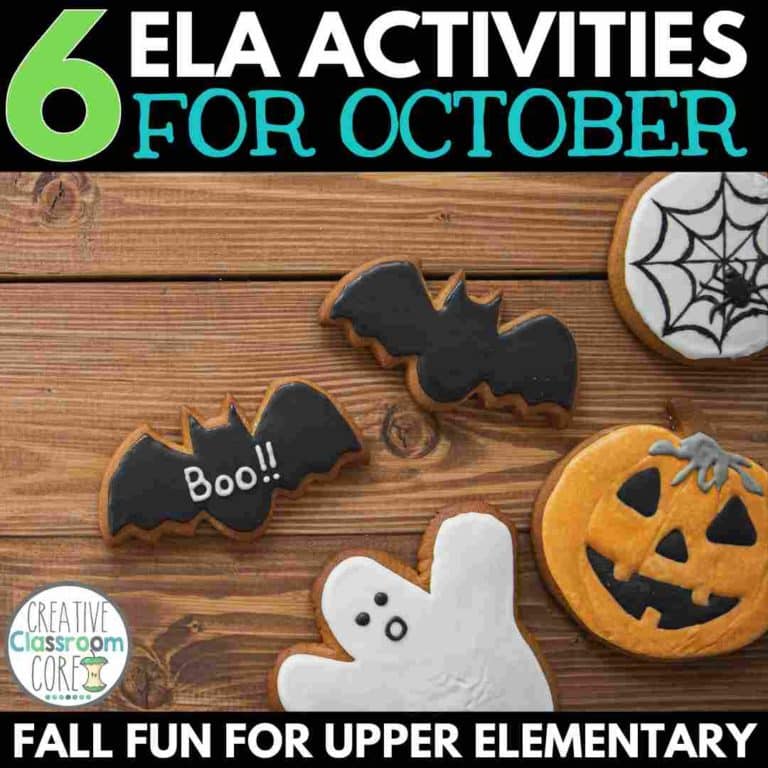
6 ELA Activities for October
By MARISSA DESPINS, RISSA HANNEKEN, MARIANNA MONHEIM, RACH JAMISON, TANYA G. MARSHALL, and RACHEL DEROCHE – Updated Oct 5, 2023 ELA Activities for October For today’s post I have teamed up…
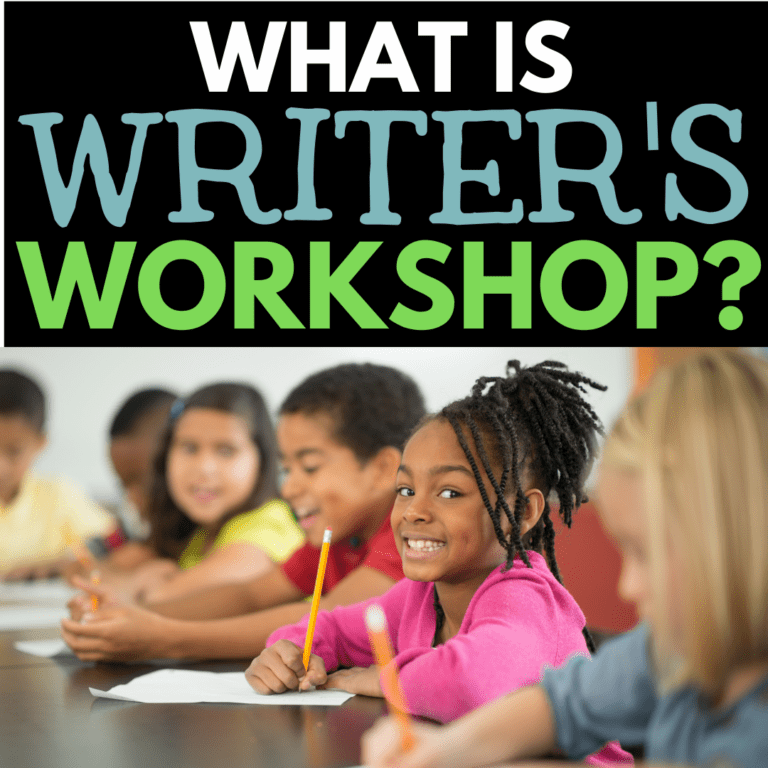
What is Writer’s Workshop?
By MARISSA DESPINS Updated April 03, 2024 Welcome to the second post in my series on Writer’s Workshop. Over the next few weeks, I will share a variety of posts on this…
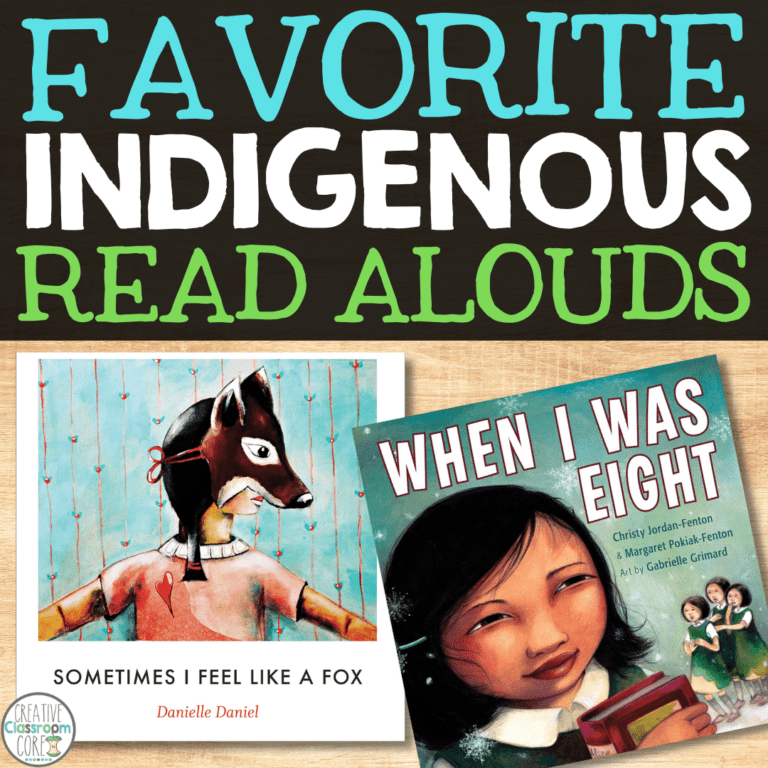
Indigenous Read Alouds
By MARISSA DESPINS Updated Sept 11, 2023 Indigenous read alouds are wonderful ways to acknowledge Truth and Reconciliation Day, and start the conversation about this important piece of Canada’s history….

Orange Shirt Day Posters
By MARISSA DESPINS Updated Sept 12, 2023 Orange SHirt Day Posters for the classroom Raise awareness with Orange shirt day posters: Sept 30th is almost here, and with it comes the important…
Classroom Freebies
June 23, 2016 · Leave a Comment
Types of Writing Anchor Chart
6-8 · All Freebies
This handy anchor chart reminds students of the purposes of the four types of writing: narrative, expository, persuasive, and descriptive.

You Might Also Like:

Leave a Reply Cancel reply
Your email address will not be published. Required fields are marked *
SPECIAL COPYRIGHT NOTE This site is copyright protected. Nothing can be reposted on this site (excluding the button features) without written permission from the author. This includes writing, photographs, images, and downloads. This blog is a collaborative blog written by a group of individuals, and each author owns and is accountable for his/her postings. Disclosure: There may be affiliate links in this post. If you click through and make a purchase, the author may receive a commission at no additional cost to you. For questions about this blog, please use the contact form link located HERE .

- Big Fresh Newsletter
- Leaders Lounge
- Live Events
- Book Guides
- Contributors
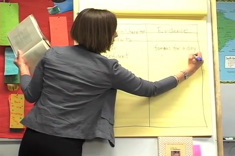
A Closer Look at Anchor Charts

Shari Frost
Peeking into classrooms at the very beginning of this new school year, I was surprised to see that many teachers already had lots of anchor charts (and completed word walls, too — but that's another article) posted in their classrooms. The charts were beautiful, with bright colors and cute illustrations or graphics. Some of them were made on desktop publishing — enlarged and laminated. Some were purchased at a teachers' store. Some were neatly lettered on manila chart paper. How did so many charts get put up so early in the school year? Were these anchor charts that the teacher had used in previous years? Did the teacher make the chart in isolation, completely apart from a lesson, without any student input? It makes me wonder if the purpose and benefits of anchor charts are really understood.
Anchor Chart Basics
An anchor chart is a tool to facilitate student self-regulation and support independence. It is visual evidence of the work done by teachers and students — a scaffold that can later be removed as soon as the students have learned the lessons reinforced by the anchor chart. Anchor charts are temporary by nature. A standard-sized version of the chart (8 ½ x 11) can be affixed in students' learning logs. Is the chart still up after several months? Then it's probably time to rethink the lesson, the chart, or the effectiveness of its location within the classroom environment.
Anchor charts are co-created within the context of a lesson or over a series of lessons. If an anchor chart is not co-created, it is destined to become wallpaper. The teacher and the students negotiate the language of the chart. The teacher acts as a scribe, capturing the students' actual words. An anchor chart purchased at a teachers' store can't ever be as effective as a co-constructed anchor chart. Even if you teach the same concepts each year, you can't really reuse anchor charts year after year because they need to be co-constructed with your current group of students. Hence there is no reason to ever laminate an anchor chart.
Some teachers like to alternate colors to help students differentiate between the lines. However, using more than two colors can actually be confusing, especially for beginning readers. Adding a photo, picture, or graphic can offer extra support in reading the chart for beginning readers. Choosing dark or concentrated colors also makes an anchor chart easier to read. When the chart is completed, it should be posted where the students can see it. Think of how difficult it would be for a six-year-old to read an anchor chart that is hung from a molding near the ceiling. Put the chart in an area of the classroom where it is needed — where students will use it and have easy access to it. The teacher and students should revisit the anchor chart frequently during the first week that it is posted. A teacher might have to remind students to refer to the chart. It is an important lesson on using resources to help students help themselves. Limit the number of anchor charts that are hanging at the same time. You don't want students to have to hunt for the chart that they need.
The Teaching Behind Anchor Charts
The respected teaching practices that are involved in getting an anchor chart launched and used in a classroom include gradual release of responsibility, think alouds, and shared writing. The teacher explicitly states his or her expectations, then models the desired practice (e.g., steps in solving a long division problem, giving an oral report), thinking aloud as s/he goes. Then the class engages in a shared experience of the task. The teacher demonstrates the desired practice with the students talking through the steps or process. The anchor chart can be co-created at this point using shared writing. Then there is a shift to guided practice, with a student modeling the desired practice for the class. The students review the anchor chart before they engage in the desired practice and use the anchor chart afterwards to reflect on how well they have succeeded. The teacher monitors the students as they attempt the desired practice and provides feedback. Finally, the students are ready for independent practice, using the anchor chart on their own to self-monitor or remind themselves what to do next.
Types of Anchor Charts
There are three common types of anchor charts: procedural, process, and strategy . The hallmark of an organized classroom is how well the students follow the classroom routines. Master teachers spend the first few weeks of school teaching routines, and report that this period of instruction is critical to the success of the entire school year.
Procedural anchor charts help reinforce the teaching of the classroom routines. Some examples of procedural anchor charts include how to use the MP3 player at a listening center or how to check out a book from the classroom library. You may find that procedural anchor charts need to stay posted for a longer period of time than other anchor charts.
Process anchor charts remind students of how to work through a process such as how to participate in a peer conference, how to solve a word problem, or how to find a word in the dictionary. In my state as part of the annual assessment, students are required to write a response to a reading passage. Most classrooms have a process anchor chart on the steps for writing a good extended response. Standard-sized copies of process anchor charts are especially useful for students.
Strategy anchor charts support students in developing strategic behaviors such as choosing what to do when encountering an unknown word while reading or how to use the text features of a nonfiction book. Consider sharing standard-sized copies of strategy anchor charts with interventionists who work with your students. It is important that these students hear consistent language.
Reflections
Pay attention to your anchor charts. Are the students using them or asking you for information available on the charts? How long do the students need them? Anchor charts would make a great topic for a grade-level team meeting. Share charts that are working well. Even more important, share the ones that didn't work out and talk about why that was the case.
Back to top
Shari Frost has enjoyed a rich and varied professional life as an educator. She has served as a classroom teacher, a reading specialist, a staff developer, and an instructor at the university level. Shari has taught kindergarten through fifth grades, and currently assists educators as a professional developer in the Chicago Public Schools. Her latest book is Two Books Are Better Than One.
Related Articles
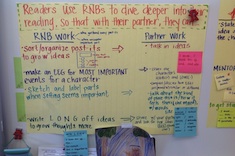
Charts as Tools, Charts as Teachers
Tara Barnett and Kate Mills give three principles they use to help avoid the “charts as wallpaper” syndrome in their fourth-grade classroom.

The Power of Charts in the Classroom
Melanie Swider shares suggestions for making anchor charts more purposeful.
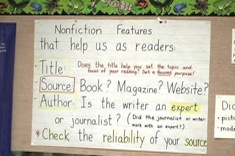
What Anchor Charts Are Essential?
Katherine Sokolowski considers what anchor charts are essential in her fifth-grade classroom, and where they work best for posting.
Related Videos
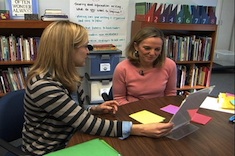
Table Charts in Second Grade
Melanie Meehan chats with second-grade teacher Nadia Egan about her ingenious use of table charts to enhance conferences and whole-class instruction.

Quick Take: Starting an Anchor Chart in Kindergarten
Mandy Robek begins an anchor chart with her kindergartners and explains the value of shared writing for creating charts about reading strategies and behaviors.
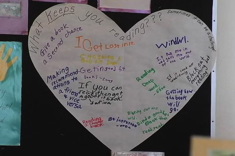
Connecting Students, Wall Charts, and Reading
In this conference with third-grade student Jeffrey, Beth Lawson helps this young reader think through the importance of developing stamina to get through the first 50 pages of a book.
Choice Literacy is a community of passionate educators who lead. Come join us!
Get free articles and insights delivered to your inbox every week with the Choice Literacy "Big Fresh" Newsletter!
© 2024 The Lead Learners. All rights reserved. Privacy Policy | Terms and Conditions
Website built by MemberDev
Lost your password?
Choose the area of the site you want to search:

Language & Grammar

Science & Social Studies

Digital Learning
7 strong narrative writing anchor charts.

Narrative Writing is my personal favorite type of writing to teach. The creativity and possibilities that come with this type of writing are endless! Today, we are going to take a look at 7 strong anchor charts for teaching narrative writing. Anchor charts are always a great tool for introducing or even revisiting a skill. In this case, the anchor charts are going to help students better understand the requirements and structure of narrative writing.
Introduce the Narrative Writing Structure

First, students will need to know what Narrative Writing is! Students will be tasked with writing narrative stories throughout their education. The anchor chart above divides the topic into personal and fictional narrative writing. Initially, students will be writing stories about events that they experienced, personal narratives. However, writing those personal stories will help students develop writing skills that will enhance their fictional narratives, too!
Next, you will want to show students the narrative writing structure. This anchor chart displays the narrative writing structure as a hamburger [or veggie burger :)]. I like to think that this structure image helps students remember that you can fill your burger with yummy ingredients (events and details), but it also needs a top and bottom (an introduction and conclusion).
Teach Students to Focus on Small Moments
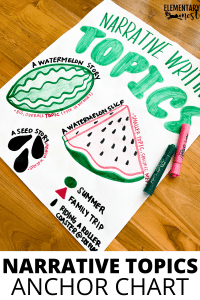
Now, students will need help narrowing their writing ideas down to a specific event. This concept is more difficult for students to understand than one would think. So, we like to use a watermelon as a metaphor.
The whole watermelon represents a broad topic or big idea, like “Summer.” You wouldn’t want to write about your entire summer in one story. So, you take a slice out of that watermelon. Maybe your family took a trip or did something fun together over the summer. The slice may represent a “Family Trip.” Within that slice, there are seeds or specific events/things that were memorable on the trip. For example, maybe it was your first time riding a big roller coaster, you made a friend at the playground, built a sandcastle at the beach, made cookies with your grandmother, etc.
Choosing one of those memories and zooming in on the details and feelings of the moment will make for a much better story than simply writing about summer.
Focus on Aspects of the Body of Writing

Our next Narrative Writing Anchor Chart will focus in on the Body of the piece. This will be all of those yummy ingredients within your story burger! You will want students to remember that a story has a beginning, middle, and end. They also need to know that within those parts, there needs to be detail and description that engages the reader. *This chart can also be made with a simple, 3-row chart where you could provide an example of each event with details. OR laminate it and reuse it over and over!
Feelings and actions are very important to narrative writing. I recommend having a mini-lesson where students can get involved in the making of a feelings and actions anchor chart. Discuss different feelings and emotions you may experience during a memorable event. Then, talk about the actions that you may do during the event or during those emotions.
Teaching Introductions and Conclusions Explicitly

Finally, you are going to need to talk about those buns! The introduction and conclusion parts of your story burger are just as important as the middle. Many times, it is more effective to write introductions and conclusions after the body of the piece has been written. Be sure to provide examples of different types of hooks and closings from narrative stories you may have read. This is a great opportunity to refer back to mentor texts you have already read. Revisiting just the introduction and conclusion, students will remember how those stories were as readers. It will help them, creatively, and keep them developing their skill!
These simple narrative writing anchor charts are going to be great tools to refer back to throughout the year!
Interested in Free Graphic Organizers for Your Writing Unit?
Or do you want ready-made lesson plans for narrative writing.
If you’re interested in getting your students to master writing without having to spend hours on planning and prep, I have all-inclusive units for you! These no-prep units have everything you need to teach opinion writing in your classroom!

Narrative Units come complete with anchor charts, lesson plans, graphic organizers, writing prompts, and more! Click the button for your grade-level below:
Want to learn more about teaching Narrative Writing?
- Mentor Texts for Narrative Writing
- How to Teach Narrative Writing
- The Importance of Pre-Writing
- Read more about: Anchor Charts , Common Core Aligned , Writing Blog Posts
You might also like...

3 Easy Times to Squeeze Speaking and Listening Skills into Your Day
In today’s blog post we will talk about incorporating speaking and listening skills in your elementary classroom! Finding time to focus on these crucial skills

Introduction to Fractions: Partitioning, Shares, and Fractions in 1st and 2nd Grade
Hello teachers! Welcome to today’s blog post, where we will dive into the fascinating world of fractions, tailored specifically for 1st and 2nd-grade classrooms. Fractions

Teaching Text Features in the Spring
This isn’t the first time we’ve discussed using the current season as a way to make your ELA content more engaging. Adding the element of
Join these happy teachers
Join the email list.
Get teaching tips, how-to guides, and freebies delivered right to your inbox every Wednesday!

Hi, I'm Jessica

I help elementary teachers master the standards by providing helpful standards-based tips, guides, and resources.

Let's Connect
Access your purchases
© Elementary Nest • Website by KristenDoyle.co

Home » Anchor Charts » What Is An Opinion Writing Anchor Chart And Where To Find One Online

What Is An Opinion Writing Anchor Chart And Where To Find One Online
Learning how to write academically can pose a challenge. Students need to get familiar with several types of writing, and it can be difficult to keep up with different formats and approaches for each writing style. Younger students especially struggle as they’re new to writing in general and need help with the basic concepts, such as paragraphs and transition words.
An anchor chart is there to help them visualize the information you present, and they can also use it as a reference point in the future. We’ll show you what an opinion writing anchor chart should consist of and where you can download high-quality, ready-to-use anchor charts for your class.
What Is an Opinion Anchor Chart
Unlike informational writing, which presents facts as they are, opinion writing is there to show the author’s point of view on a specific topic and to persuade the reader to agree.
An opinion anchor chart is a teaching tool that helps students get a visual representation of the writing format, as well as some of the writing concepts . The chart also serves as a reminder they can turn to when writing their essay.
A writing anchor chart can focus on different elements of writing, but you should always start with the ones that focus on the structure, such as:
- Introduction anchor chart
- Paragraph anchor chart
- Conclusion anchor chart
- Body paragraph anchor chart
Elements of a Good Opinion Writing Anchor Chart
How exactly would you create an opinion writing anchor chart? Well, again, much like opinion itself, that varies. How you do it depends on your students’ age and cognitive level. Even so, however, the basic anchor principles are the same. How far you go with them can be adapted to suit the grade level.
Differentiate between ‘fact’ and ‘opinion’
Fact and opinion are both important in writing a good opinion piece because they serve different purposes. Facts provide the foundation or support for an opinion. In contrast, opinions are the main idea or position the student tries to express.
It’s important to differentiate between the two so that students understand how to use them effectively in their writing. And, believe it or not, they often struggle to understand the difference.
For example, they may think a statement like “John thinks ice cream is the best food on earth” as an opinion, informing the reader of John’s attitude towards ice cream. However, the fact remains that John thinks ice cream is the best food on earth.
An opinion would be assuming that everyone should feel the same way. For example, “Ice cream is by far the best food on earth”.
An opinion piece without any facts to back it up is likely to be less convincing and less effective. Finding a middle ground between the two is important to write an effective opinion piece.
Show the differences between an opinion piece and a commentary
Students often confuse an opinion piece with a commentary. An opinion piece is a personal response to an issue – like a current event, a school or home rule, or even a new menu in the cafeteria. A commentary, on the other hand, is an unbiased analysis of an issue or topic. But, unlike an opinion piece, a commentary doesn’t offer the writer’s personal take on a subject.
You can illustrate this with a chart or table that shows the differences between opinion and commentary. For example, in the “Opinion” column, you might write, “Opinion is personal,” ; whereas in the “Commentary” column, you could write, “With commentary, it’s nothing personal” .
Show them how to organize their ideas with an essay outline
Create a simple visual representation of the framework – or essay outline. An opinion piece can’t be written off the bat. Students will need to construct an opinion piece. A standard essay outline lists the main points covered in the piece. So, first, pick a topic.
Alternatively, each student can pick their own topic, and you can all work on your anchor charts together. Next, create a mind map of the beginning, middle, and end of the “story” or opinion that needs to be put across: i.e., opening statement, argument, and conclusion.
Demonstrate persuasive writing
An opinion piece is written to persuade the reader to share the writer’s point of view on a topic. To write an opinion piece, you must develop the three key components from the previous point above a strong opening statement, an argument (or supporting paragraphs), and a concluding paragraph.
The first paragraph should grab readers’ attention and offer a detailed topic summary . The second paragraph should feature one or more supporting examples to help prove your point. The final section should conclude the topic and summarize the main points of your opinion piece.
Writing Hooks Anchor Chart From Sassy Savvy Simple Teaching
Opinion writing hooks anchor charts are the first charts you should introduce to your students when it comes to actual writing. Use charts to show them what a hook is and how they can use it to pull the reader in.
Since writing a hook can be difficult for students, try to provide them with colorful examples and leave empty spaces for them to fill out. This will help them get a visual aid of hooks and start their creative process.
You can have an anchor chart that focuses on one or all of the most common hook types:
- Interesting fact
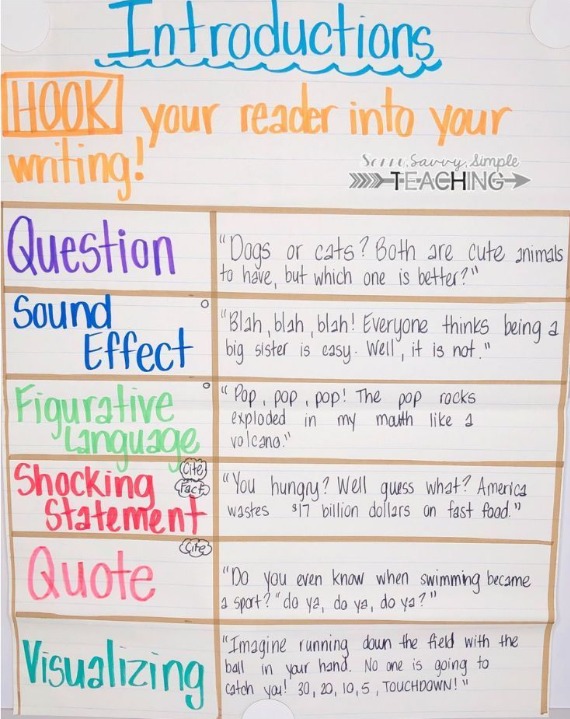
Opinion Transition Words Anchor Chart From Weebly
Show the students how they can link sentences and paragraphs together with transition words. This is a powerful tool that many students (especially younger ones) neglect, and they can get used to using it by having a chart by their side. This chart can help them come up with the appropriate transition word. As time goes by, using transition words will become more natural, and they won’t have to refer to the anchor chart every time.
You can use different designs here, depending on how you want them to use transition words. For example, you can use a stoplight design and give examples for three types of transition words:
| Green—Beginning | In the beginning Once upon a time To begin with Firstly First off |
| Yellow—Middle | Meanwhile Next Then Second Secondly Furthermore After that Later |
| Red—End | Last Lastly Finally At last Third In the end To summarize In conclusion |
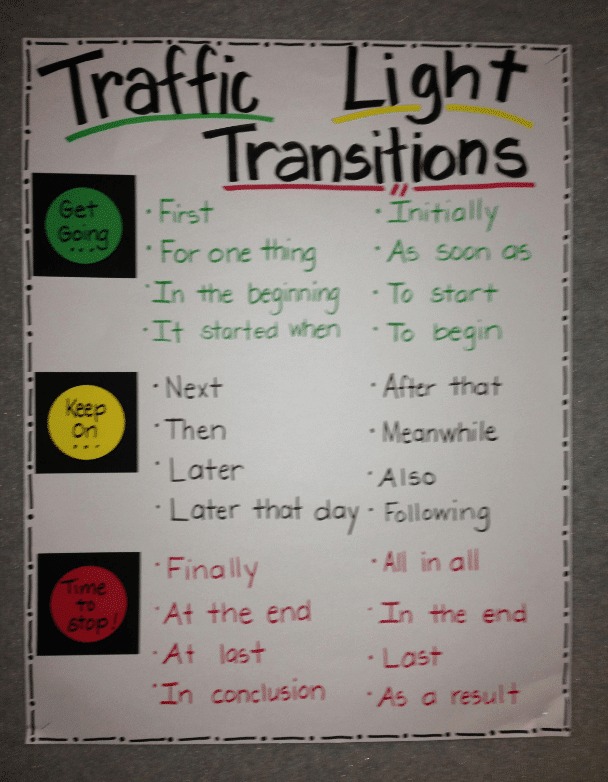
Opinion Reasons Anchor Charts—OREO From Our Global Classroom
Opinion Reasons anchor charts are great as they teach students about the structure of a good opinion writing piece. It shows how they’re supposed to present their thoughts and how to reinforce them with logic. Having a memorable acronym is only a bonus.
Use this chart to introduce the OREO formula and show students how to present their ideas. The formula is as follows:
- Opinion —Introduce your opinion about a given topic
- Reason —Provide information or logical explanations that support your opinion
- Examples —Give details and real-life scenarios that support your opinion
- Opinion —State your opinion again to affirm your point of view
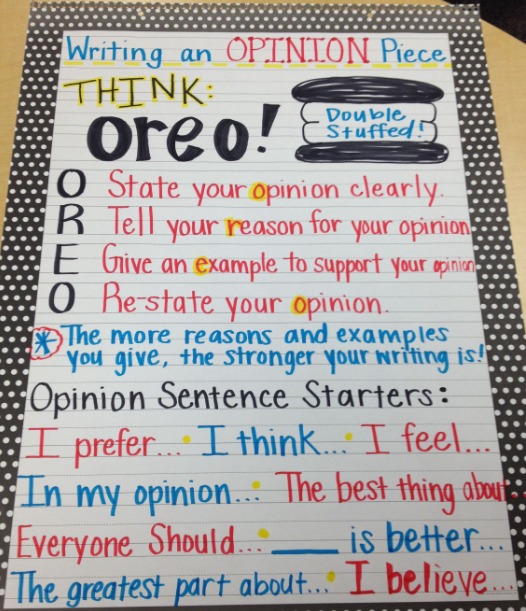
Download High-Quality Opinion Writing Anchor Charts From Teach Simple
While writing anchor charts can be straightforward, and you can even get your students to make them, they still need to be carefully thought out. How do you make sure you use all the necessary information and the easy-to-remember definitions? Planning an anchor chart can be difficult, and it can take you hours, especially if you’re new to it.
If you don’t have the time (or the will) to come up with your own for every class you plan, you can sign up for Teach Simple and find thousands of lesson plans , anchor charts, and other materials related to ELA and writing in particular.
Every product listed on Teach Simple is made by a teacher exclusively, and other teachers review each material to ensure it meets various standards and quality requirements. This way, you can rest assured you’ll enrich your classes with high-quality anchor charts made by people who know what it takes to teach students different types of writing.
Different ways to use anchor charts to teach opinion writing
Let’s look at how anchor charts can be used differently to highlight opinion writing.
Scaffolding From Lucky Little Learners
Students who are not proficient in each element of scaffolding writing can become overwhelmed quickly, so instruction in these elements is crucial. However, breaking them down into bite-sized portions will make them much more manageable.
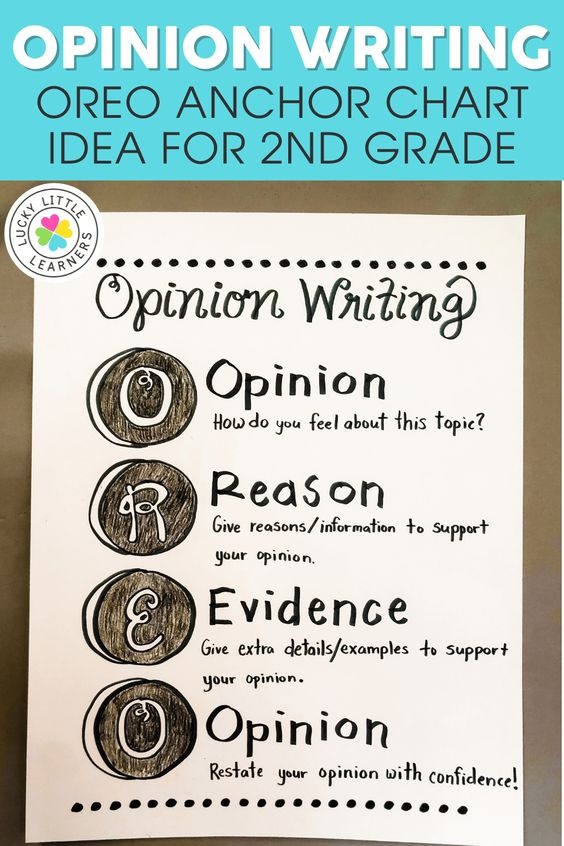
Fact Vs. Opinion sorting From Lucky Little Learners
Sorting facts and opinions is something that should be done in groups. What better way to get your students to express their opinions? And you can build the anchor chart together, making it far more relevant to the students. You could use many techniques to practice this skill with your team. For example, ask your students to jot down one thing they know about broccoli on a post-it note and stick it to the board. The students will typically write that it’s green, tasty, gross, healthy, and a vegetable. Once the notes are placed on the board, discuss whether a claim is a fact or an opinion and categorize it.
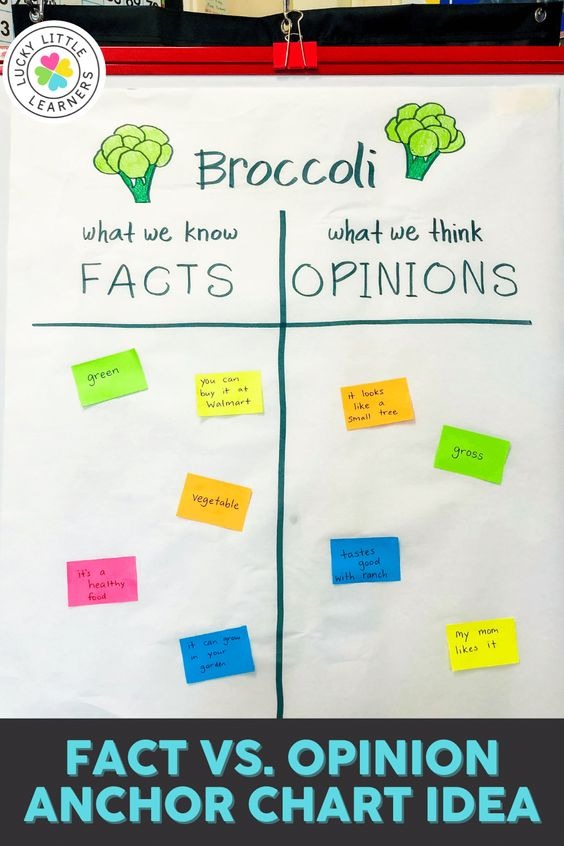
Display examples
It is essential to show students what various levels of mastery look like. Showing your students examples of completed writing can help them visualize expectations and encourage them to keep working and growing.
Model good opinion writing from Mrs. Winter’s Bliss
To illustrate how you would use a graphic organizer to plan your writing, model it for your students. At the beginning of your writing, introduce your perspective with a topic sentence. Next, list your supporting arguments. Finish with a final sentence that reiterates your viewpoint. As a group, identify the topic sentence, the supporting reasons, and the conclusion in your shared writing.
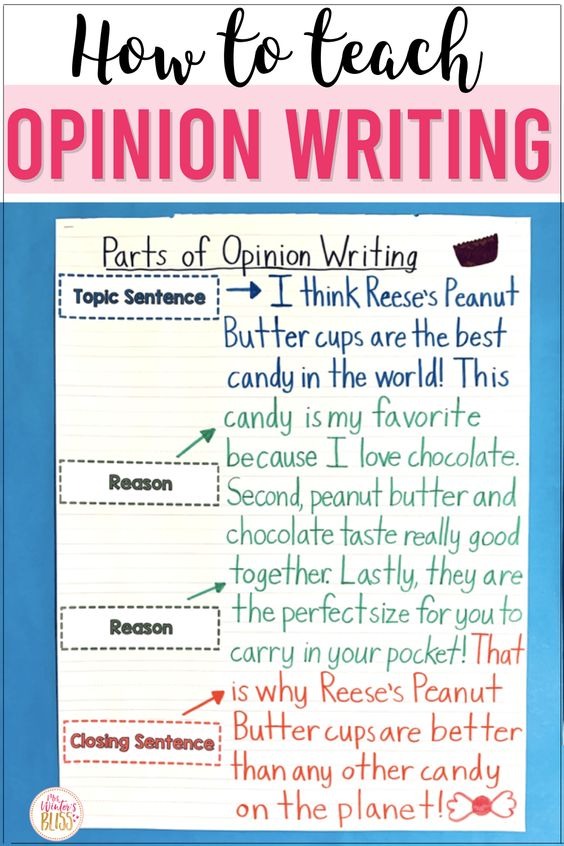
Opinion Essay Structure From Wild About Fifth
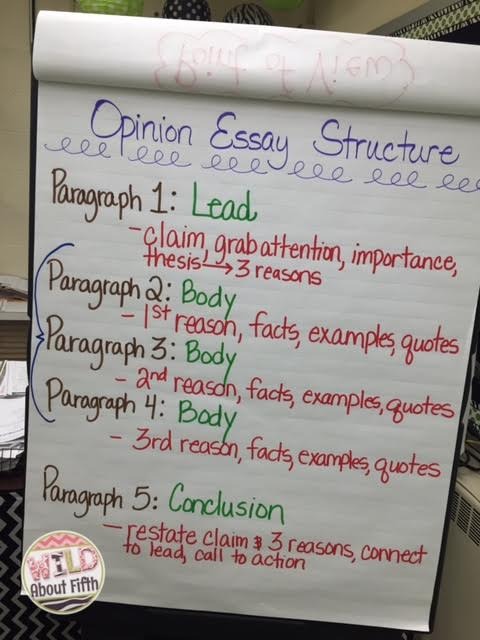
Opinion writing resources from Teach Simple
Looking for an opinion writing chart that covers all the bases? Here is everything you need. All these charts and resources support the elements you need to get started to ensure your students understand how to express their opinion in writing.
Opinion writing anchor chart By First in Line
These charts give students the O.R.E.O. acronym to remember and can be placed on a display board or in their notebooks.
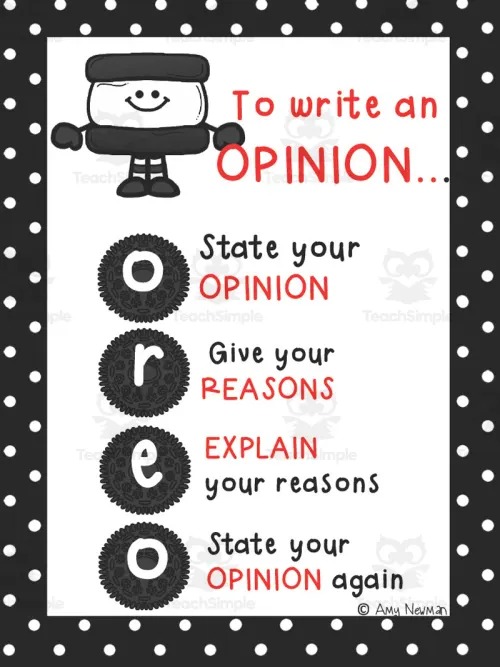
Digital graphic organizers By Teach Me This
This resource is jam-packed with digital opinion writing templates that will give your students multiple opportunities to practice this comprehension strategy.
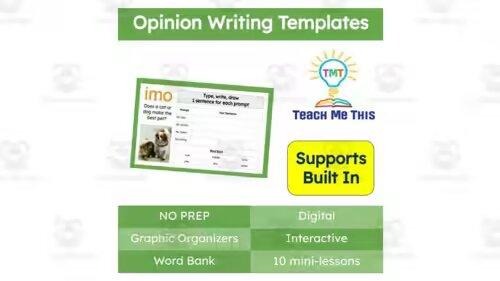
“What do you think?” opinion writing activity By Have Fun Teaching
This graphic organizer is perfect for younger students and guides them every step of the way.
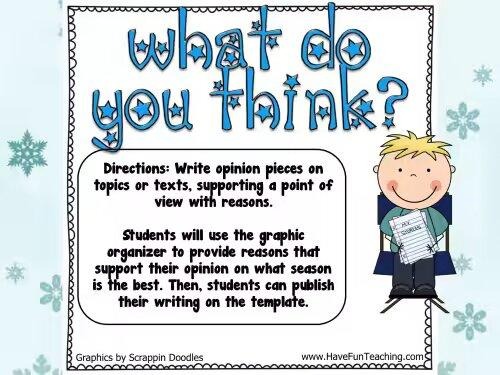
“Would you rather…?” By Aunt Minty’s Education Place
This resource is compiled with 20 high-interest opinion/persuasive writing activities designed for students in Grades K-3.
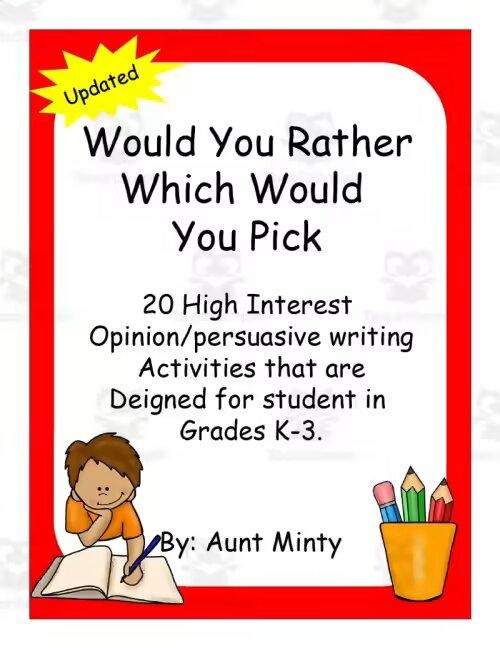
Opinion writing unit – analyze two accounts of the same topic
This resource lets students practice analyzing multiple versions of the same issue and integrating their learning into a complete opinion response.
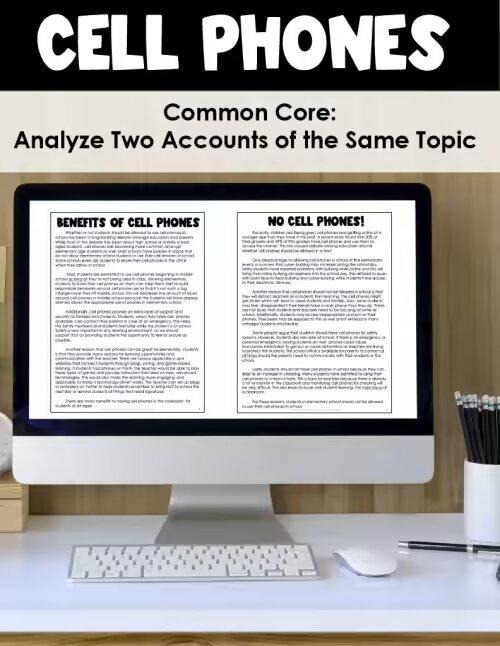
Opinion writing unit: paid for chores By Life Beyond the Gradebook
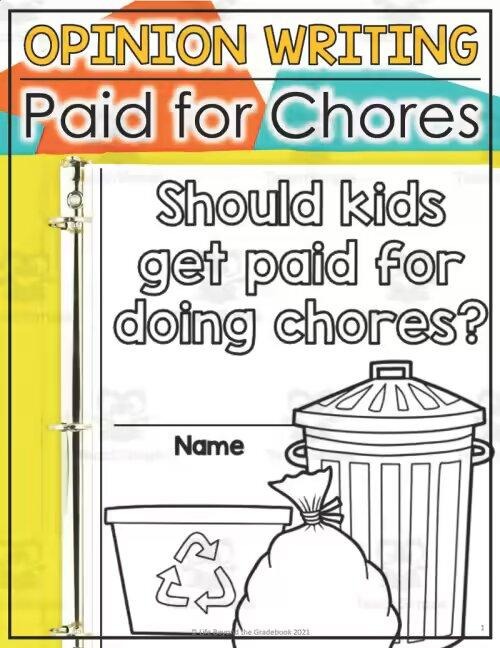
Two texts are included in this resource, one in support of the topic, and one against the topic. The students should use these texts to find evidence that supports their own opinion and use it in their essays.
Opinion writing Anchor Charts from Teachers
Opinion transitions from art of it.
Sentence starters and transition examples can ease students in and take some of the pressure off.
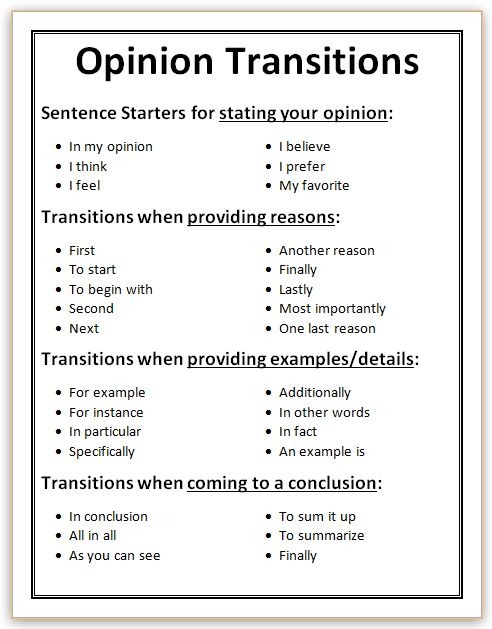
Opinion writing planner From Art Of It
This prewriting graphic organizer will guide students through their planning process.
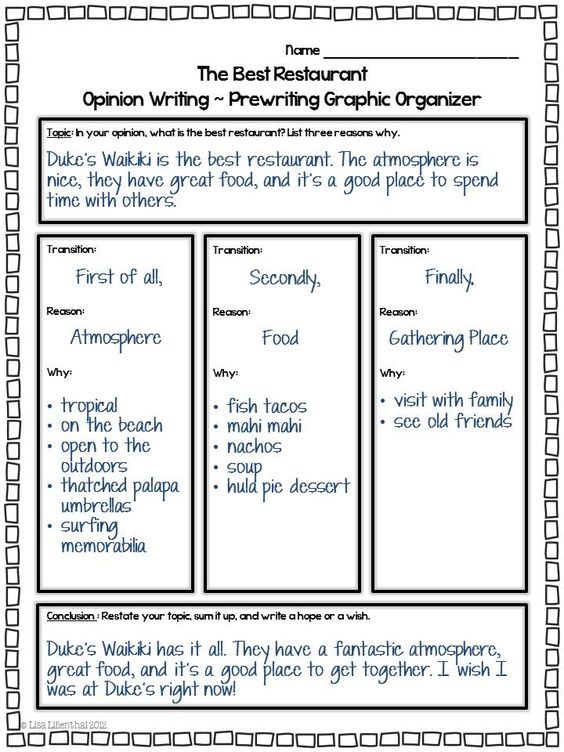
Opinion writing checklist From Worksheetplace
This checklist is great for helping students check their work to ensure they have covered everything.
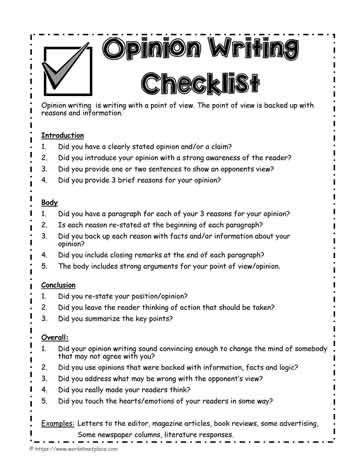
Having a wide variety of opinion anchor charts available can help break down a topic into smaller chunks and make it easier to understand. In addition, using visual aids like anchor charts helps make the lessons more memorable and engaging. Finally, when students need a confidence boost, they are usually grateful to have something to refer so they can move forward independently.
Check out our top pick for anchor charts for writing :
- Opinion Writing Anchor Chart
- Writing With a Purpose Anchor Chart
- Anchor Charts for Writing
- Appeal to Senses Anchor Chart
- Poetry Writing | Anchor Charts & Visuals
- Anchor Charts Professional Development
- Fact and Opinion Anchor Chart
- Idioms Anchor Chart
- Homophones Anchor Chart
- Writing a Beginning, Middle, and End
- Verbs Anchor Chart
- Nonfiction vs. Fiction Comparison Anchor Chart
- Teaching Plot Anchor Chart
- Author’s Claims Anchor Chart
Share Article:
Download unlimited teaching resources, join free today, teach simple.
The team behind Teach Simple is a small but dedicated group who are passionate about education and making a positive impact on the lives of teachers and students.
We have a lot of interesting articles and educational resources from a wide variety of authors and teaching professionals.
What Is A Theme Anchor Chart And Where To Get Them Online
Informational writing anchor charts—what types there are.
Last Updated on August 30, 2023 by Teach Simple

- teaching writing
8 Easy Ways to Use Elaboration Anchor Charts For Teaching Writing
It is a common teaching practice for teachers to use elaboration anchor charts to show students where and how they should elaborate on their writing.
I have always enjoyed using these elaboration anchor charts to teach writing to my students about the different types of elaboration.
However, I run into the problem that many of them need to remember to refer to them while writing an essay because they glance at them once and forget they exist.
So, this got me thinking, how else can I use these elaboration anchor charts after our writing lesson?
Read along to find eight easy ways to use elaboration anchor charts to teach writing besides displaying them on your classroom wall.
Table of Contents
Repurposing Your Writing Anchor Charts
Make an interactive bulletin board by adding mentor sentences.
Pass out sticky notes and have kids write examples of sentences they have included in their paragraph that matches each elaboration poster.
In the end, you will have a collection of mentor sentences to use with them.
Use a document camera to display the elaboration anchor charts
Before adding the elaboration strategy anchor charts on a bulletin board, you can introduce each elaboration technique by placing them under the document camera.
Then, prompt kids to read the examples and discuss each type of elaboration.
Use them as table signs for group work
Next time you have your students do group work, name each group using an elaboration strategy. Then, use the anchor charts as table signs.
If we want them to use the vocabulary words associated with writing, we must give them opportunities to practice using them.
Make an interactive revising activity
Here is an idea of a revising activity you can implement in your next writing lesson.
Start by adding each elaboration anchor chart to the top of a chart paper.
Then, include one paragraph underneath the elaboration anchor chart to revise. Finally, students can brainstorm ways to add that particular elaboration strategy in groups.
If you have them rotate through each elaboration, you will ultimately have different versions of the paragraphs and a great start to a classroom discussion.
Paste the elaboration posters in their writing notebook
If your students have a writing notebook, these elaboration posters would be a great addition to use as a reference.
Size down each elaboration anchor chart to 80% to fit the space of a composition notebook.
Students can easily refer to them throughout the school year. Now you will have space on your wall to add the next set of writing skills.
Create an anchor chart comparing and contrasting different types of paragraphs
Another writing mini lesson to add to your writing toolbox is to compare different types of elaboration to distinguish the differences among each type of elaboration.
It is a common mistake among new essay writers to need clarification about which elaboration strategy best fits their paragraphs.
Comparing two elaboration strategies at a time gives your students more writing practice, making them more likely to remember each elaboration strategy.
You can also use this classroom idea to help you differentiate your writing lesson.
Make an elaboration reference guide
Do you know you can print multiple pages on just one paper?
With this teacher hack, you can make an elaboration reference guide quicker than taking attendance!
Follow these steps to make your elaboration reference guide.
First, open the elaboration anchor charts file and continue the printing steps. Next, select the option to print multiple pages in one sheet in your printer setting.
Before pressing the print button, preview how the paper will print. Last select print if you are happy with your settings. You can go up to 16 pages in one sheet!
Use a Binder Clip to Hold the Elaboration Anchor Charts
Print the elaboration charts smaller and laminate them to place them in a binder clip or ring holder.
Now you can use them when working with students in a small group.
Your students can refer to these elaboration charts while brainstorming or writing essays.
Wrapping It Up
While elaboration anchor charts help teach different types of elaboration, there are alternative ways to use them than just being displayed on a wall.
They can be effective teaching tools when used creatively and strategically in the classroom.
As we discussed, they can be effective teaching tools when used creatively and strategically in the classroom.
Resources Featured
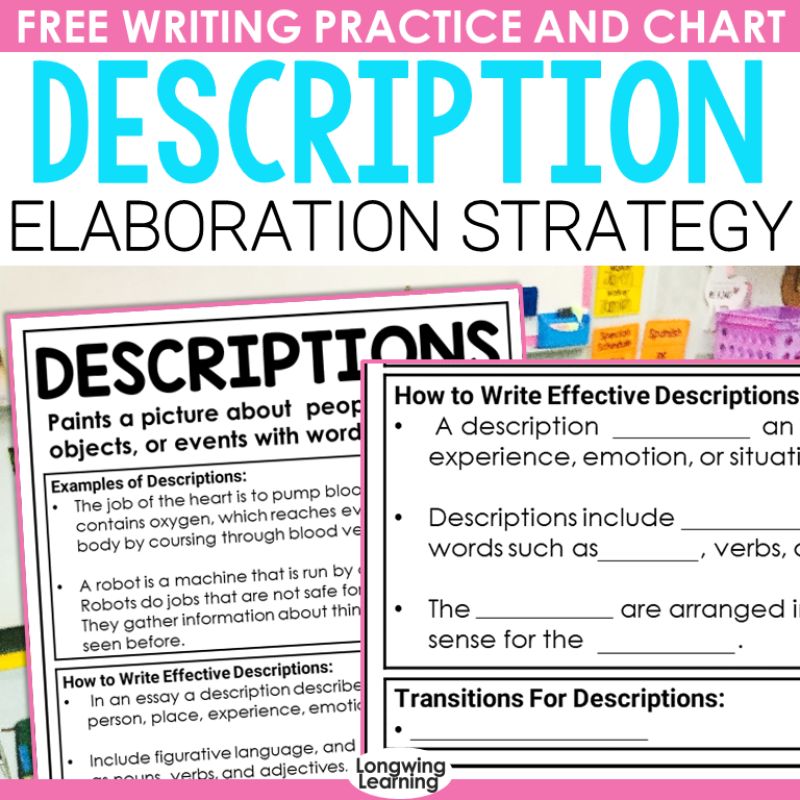
2 thoughts on “8 Easy Ways to Use Elaboration Anchor Charts For Teaching Writing”
absolutely brilliant, if possible show part two with examples for these demonstrations!
Pingback: 4 Lesson Plan Ideas On How To Add Details To Writing In 4th Grade - Longwing Learning
Leave a Comment Cancel Reply
Your email address will not be published. Required fields are marked *
Vanessa I Longwing Learning
You might also enjoy....

13 Secrets For Making Beautiful Bulletin Boards
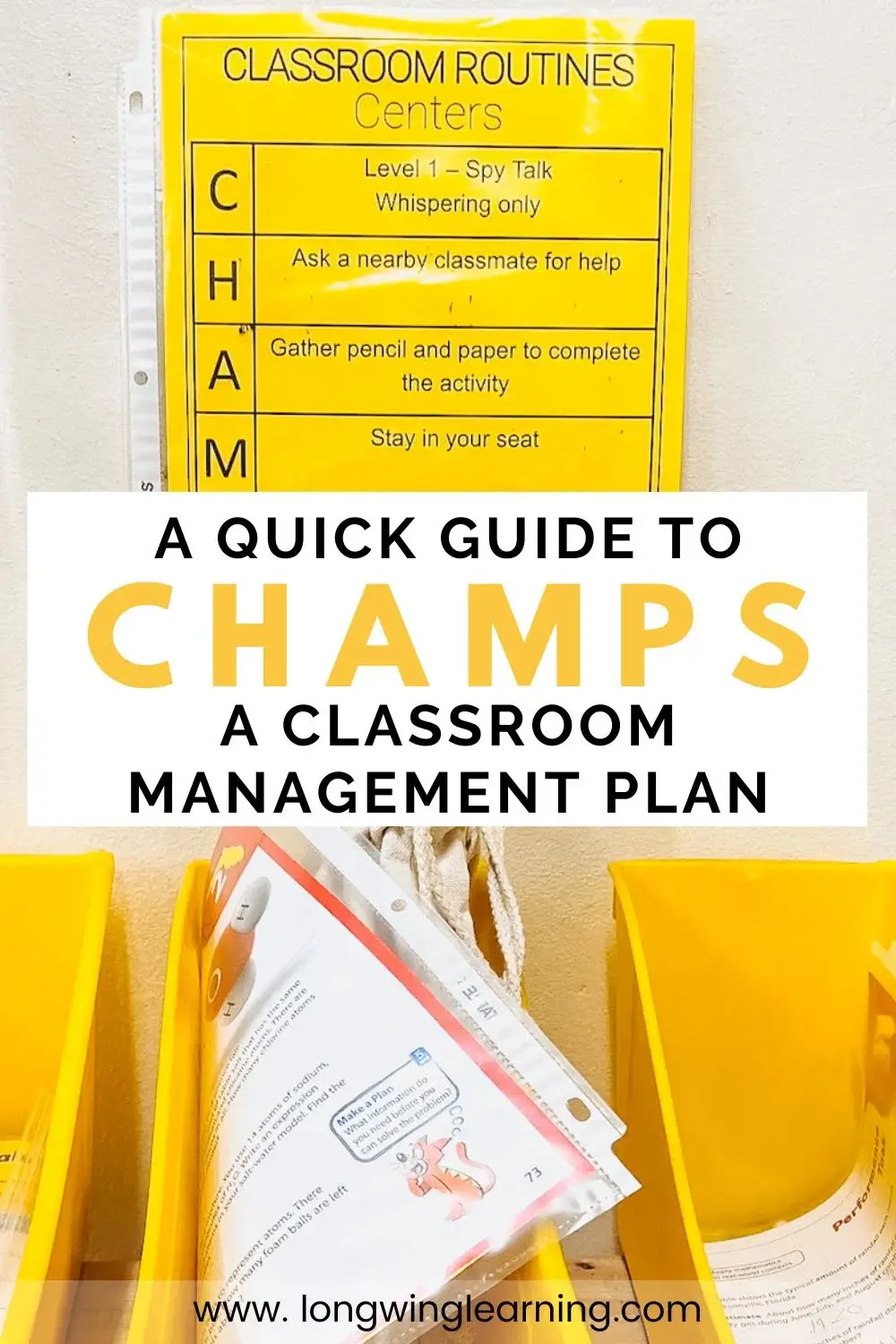
A Quick Guide to CHAMPS: A Classroom Management Strategy
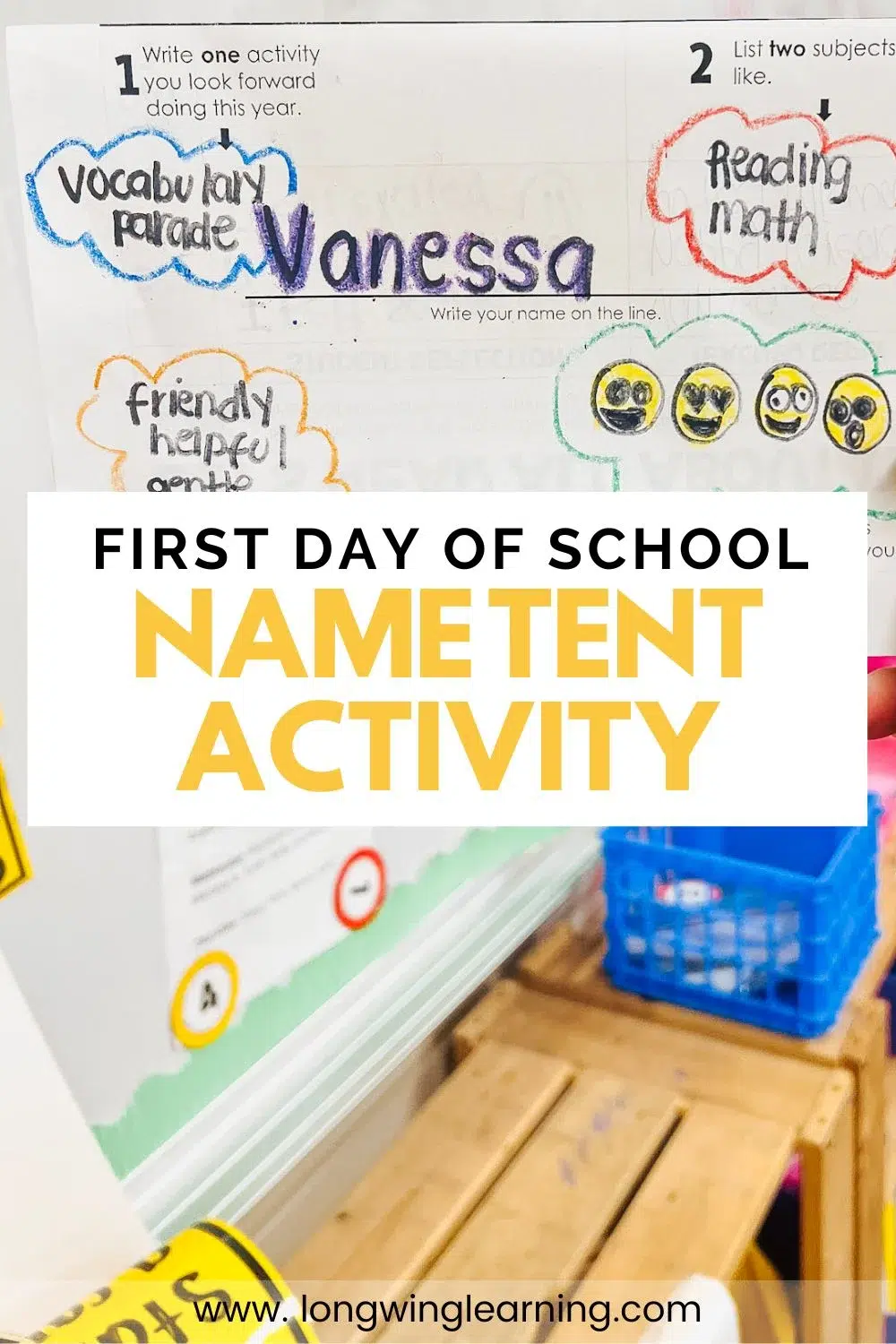
Name Tent Activity For the First Day of School + Free Template
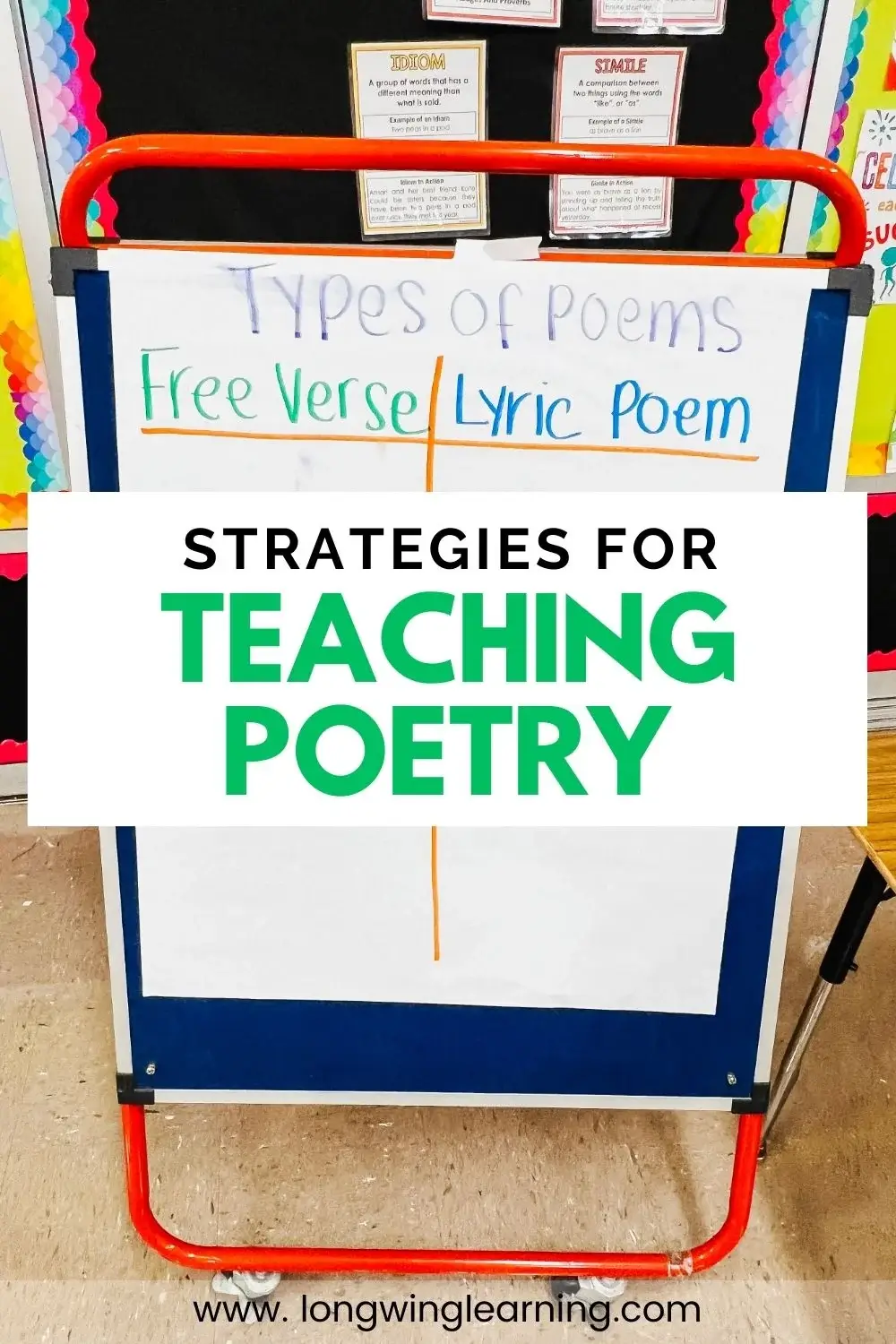
7 Strategies to Feel Confident Teaching Poetry in Upper Elementary
Looking for The Read Aloud Library? 📖 LOGIN HERE

- Professional Development
Shop Resources
February 6, 2016
9 must make anchor charts for writing.
My first few years of teaching I was “given” writing for my team planning assignment. After digging my heels in with writing for a few years and in different grade levels, it ignited a love for teaching writing. I wanted to share with you some of my favorite writing anchor charts that will be WONDERFUL for your students to refer to throughout their time as the blossom into little authors.
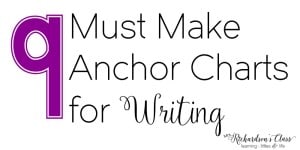
My bulletin board below has three anchor charts on it.
- On the left is a printable version of Cara’s anchor chart above.
- In the middle is an absolute favorite writing anchor chart that I would create every year as I taught Kindergarten. It was so good for them to see the stages of writing and know that we, as a classroom, would be celebrating ALL writing!
- On the right is an anchor chart that we created early on in writer’s workshop.
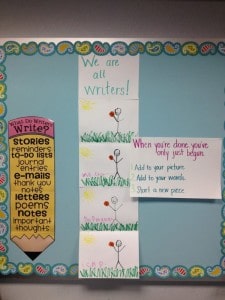
Finally, this writing anchor chart by The Brown Bag Teacher is fabulous! She models for her students the progression of writing and her expectations! The students are able to look at their writing and compare it to the chart she has provided. This is almost like a first grade version of the writing anchor chart I created above to know that we are all writers!
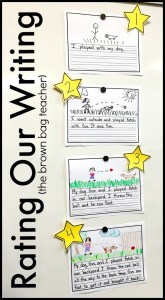
I hope you are leaving inspired to create more writing anchor charts during your writing lessons for and with your students! If you are looking for anchor charts for math , reading , science , or social studies be sure to check out my posts about those!
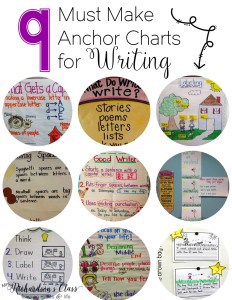
Happy Teaching,
Writer's workshop posters.
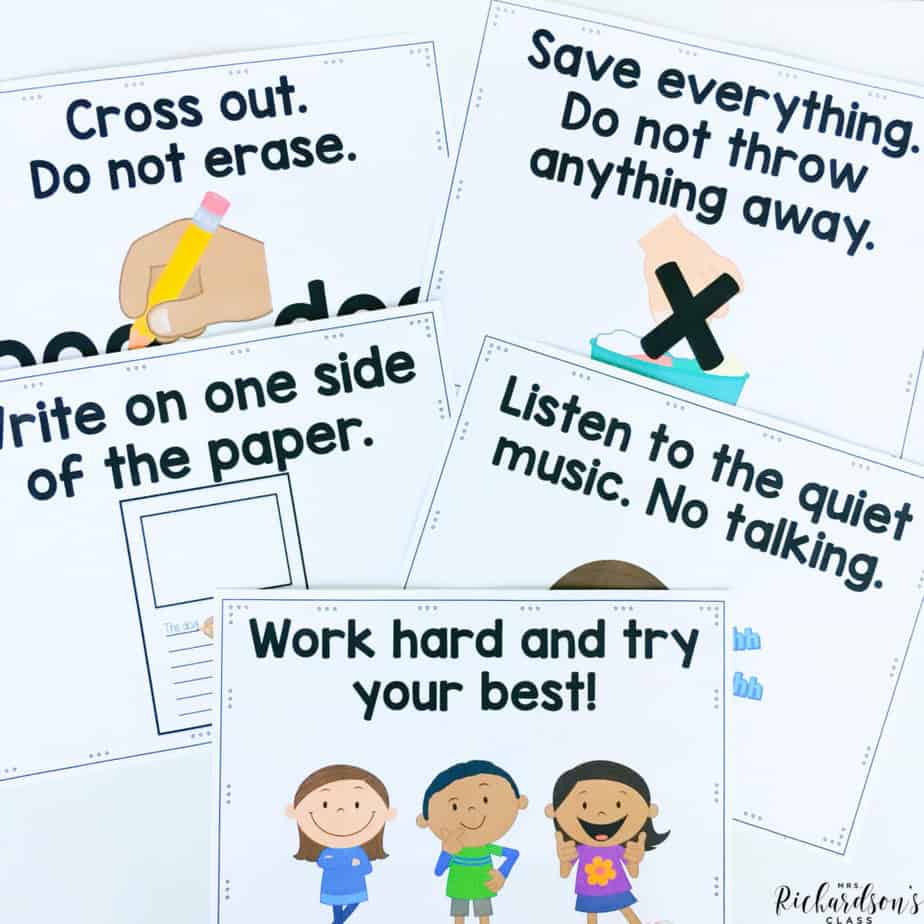
Hi, I'm Amanda
I’m a K-1 teacher who is passionate about making lessons your students love and that are easy to implement for teachers. Helping teachers like you navigate their way through their literacy block brings me great joy. I am a lifelong learner who loves staying on top of current literacy learning and practices. Here, you’ll find the tools you need to move your K-2 students forward!
Handwriting Practice and Work Station

Handwriting Work Station (D’Nealian)
You may also enjoy....
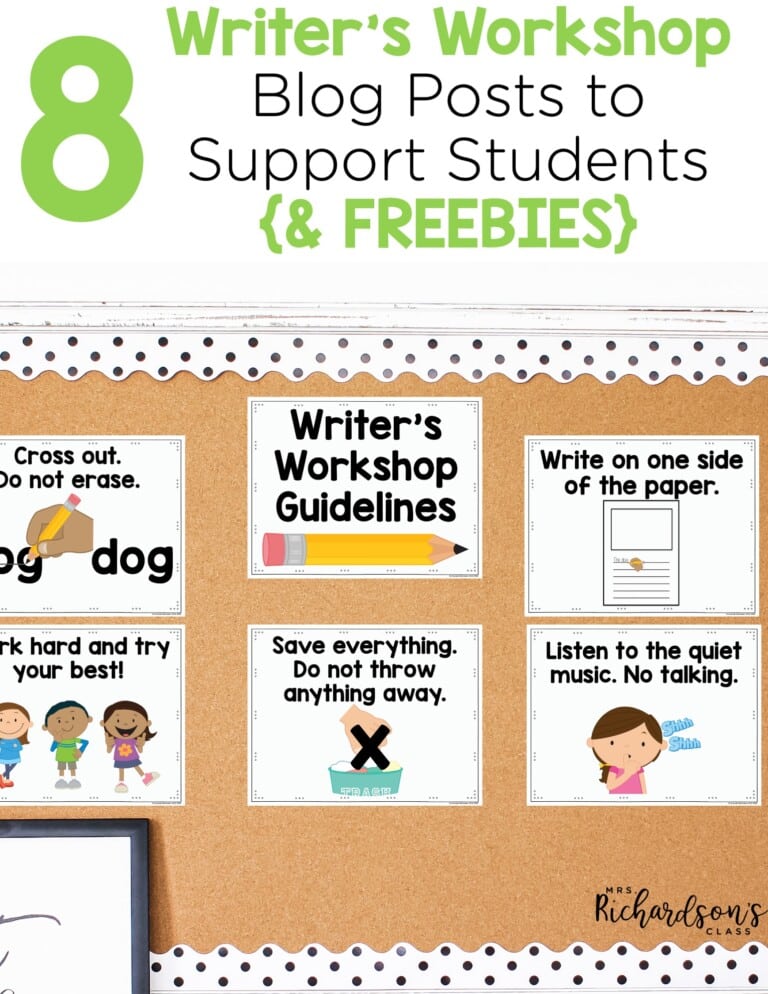
7 Responses
Thanks for the great resources
- Pingback: 6 divertidas ideas para que los niños escriban sin parar - Elige Educar
Love this!! Do you have a link to print off the pencil anchor chart that says “what do writers write?” 🙂
Hi Lizzie! I do not. You can search on Cara Carroll’s blog–The First Grade Parade. 🙂 She made it many years ago, I believe!
Fantastic ideas! Thanks for sharing!!!! Cintia
On medical leave right now. Lots of pages to print. School does not provide paper and copies must be approved.
Leave a Reply Cancel reply
Your email address will not be published. Required fields are marked *
- Read Aloud Library Login
- My Wishlist
- Privacy Policy
- Terms of Service

©2021 MRS RICHARDSON'S CLASS. ALL RIGHTS RESERVED.
Site by ashley hughes.

Which type of professional development interests you?
Literacy training videos, online workshops.
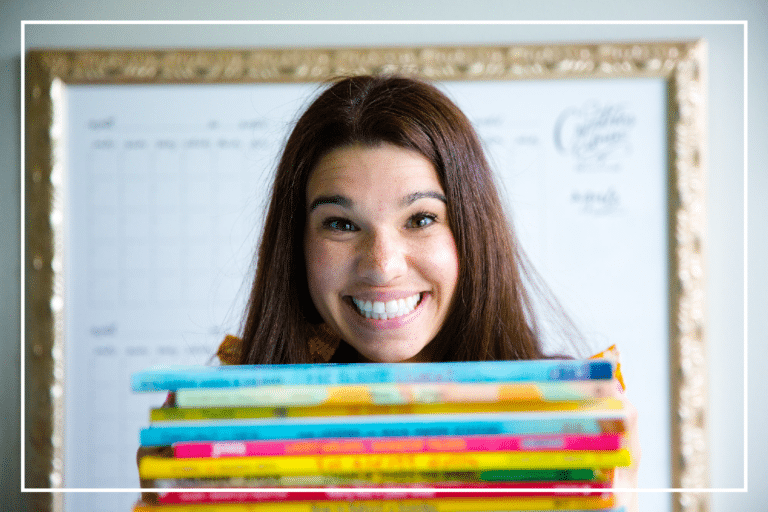
What are you looking for?
Privacy overview.
| Cookie | Duration | Description |
|---|---|---|
| cookielawinfo-checkbox-analytics | 11 months | This cookie is set by GDPR Cookie Consent plugin. The cookie is used to store the user consent for the cookies in the category "Analytics". |
| cookielawinfo-checkbox-functional | 11 months | The cookie is set by GDPR cookie consent to record the user consent for the cookies in the category "Functional". |
| cookielawinfo-checkbox-necessary | 11 months | This cookie is set by GDPR Cookie Consent plugin. The cookies is used to store the user consent for the cookies in the category "Necessary". |
| cookielawinfo-checkbox-others | 11 months | This cookie is set by GDPR Cookie Consent plugin. The cookie is used to store the user consent for the cookies in the category "Other. |
| cookielawinfo-checkbox-performance | 11 months | This cookie is set by GDPR Cookie Consent plugin. The cookie is used to store the user consent for the cookies in the category "Performance". |
| viewed_cookie_policy | 11 months | The cookie is set by the GDPR Cookie Consent plugin and is used to store whether or not user has consented to the use of cookies. It does not store any personal data. |
- Skip to main content
NEW PROFESSIONAL DEVELOPMENT BOOK: Simplify Your Writing Instruction
Performing in Education®
- Simplify Writing®
- Simplify Science™
- Launch PBL™
- Simplify Your Writing Instruction
- Project-Based Learning Made Simple
- NGSS-Aligned Picture Books
- Daily Warm-Ups
- Escape Challenges
- Interactive Notebooks
- Project-Based Learning
- Picture Book Units
- How to Engage Every Student During Writing
- How to Deliver Insanely Engaging Science Lessons With Limited Time & Materials
- How to Support Your Teachers and Raise Writing Scores
- Search this site...
3 Tips for Teaching Poetry + FREE ANCHOR CHARTS
So poetry is not my favorite thing to write, and it’s not always easy to teach. This is especially true when teaching fourth and fifth-grade students when you’re dealing with lots of different types of poems with confusing rules. So, I’m going to share three ways to teach poetry and make it fun, even if it’s not your thing.
We’ll focus on how to break down those rules, make it easy for students to understand and write, and make it easy for you to teach.
1. Use Engaging Examples
So my first tip is to use engaging examples with your students. There are a lot of poems in textbooks, workbooks, and online that aren’t going to be relevant to your students. Instead, you want to find poems that your students understand. You don’t want to throw something at them that is such an old poem that you don’t even understand it yourself.
You want to start with silly, fun, and engaging poems.
Here are a few of my favorite poetry books:
- A Stick is an Excellent Thing by Marilyn Singer
- Love That Dog by Sharon Creech
- My First Book of Haiku Poems
You can also go to your local library and find many poetry books for kids. Check out the ones with the best examples of the types of poetry you’re teaching. Then, you can bring those books into your classroom and immerse your students in the poems.
You want poetry to be all over your classroom while teaching it. Again, it may not be your favorite thing, but the more it’s in the classroom, the more you and your students will engage with it.
If you’re interested in using anchor charts with engaging examples to help illustrate the different types of writing for students, you can download these free Poetry Anchor Charts . This resource includes all the different types of poems we teach in upper elementary. They use engaging pictures and fun poems while also highlighting the rules.
These anchor charts are great to use in your classroom with students. They catch their eye and immerse them in a poetry experience while focusing on the key rules for the different types of poems.
Learning about the different types of poems is really just about looking for the patterns and rules that go with them. It takes a lot of practice and is something you can’t just teach in a couple of days. So, it will be something you do for a while, which leads me to my second tip.
2. Annotate the Poem
You want to give your students a lot of examples they can write on. Reading poems together is great, but you want to have some poems where students can actually observe something and write it down. For example, you want them to be able to label syllables, the number of lines, rhyming words, and anything they notice about the poem.
They might not notice more than the actual rules, and that’s okay. But we want to have students look deeply at the poem’s structure to identify what type of poem it is and what rules go with it.
So the anchor charts you get in the free resource mentioned above can also be printed small. For example, I like to print them two to a page and have students cut them out after they annotate so they can paste them into their notes.
You will walk them through the process of looking for patterns and rules as they’re annotating. So let’s use a limerick poem as an example.

Your students may notice the poem is kind of silly. They should also notice there are five lines. The first, second, and fifth lines rhyme and have seven to 10 syllables.
This poem is kind of a complicated structure because the third and fourth lines also rhyme and contain five to seven syllables. These patterns are very complicated, especially with a limerick. So noticing this is going to be a little tricky for students. So, you’re going to walk them through the process, have them annotate it, and then do multiple examples.
I like to do this by introducing one type of poem each day and then spending a few days on multiple types of poems while comparing and contrasting them. Doing it this way makes it a lot easier for students to be able to work with various types of poetry and how to identify them.
3. Do a Collaborative Poem
Work together with students as they start to write poems. We want to begin together so they know the process and how to use the rules. So, we can brainstorm ideas together and write a poem with the correct structure using our ideas.
If we don’t do one as a group, we’re basically throwing our students in without a process. Doing this tends to result in them not following the rules or getting really stuck. I have a hard time writing poetry, so I can only imagine my third, fourth, or fifth graders and how they feel about writing a poem when they’ve never written this type of poem before.
So, writing a collaborative poem as a group is really important. That way, students know the process. Then, when they’re more comfortable, you can move into having students do this in small groups or with a partner. Eventually, you can have them work independently.
I know this sounds like a lot of time spent on teaching poetry since you’re working on it every day for almost two weeks if you add all these activities together. But I think that poetry is something you should spend time on.
Not only is it developing writing skills, like descriptive writing and formatting, for your students, but they’re also building amazing reading skills. They will be able to look at a poem, identify the rules and patterns, and have opinions on them. So, there are actually a lot of standards that poetry covers.
Resource for Teaching Poetry
So those are my three tips for teaching poetry, even if you’re not in love with it.
Don’t forget to download my free poetry anchor charts to try in your classroom. You can print them full size to use on bulletin boards. Or, if you want students to use them in notebooks, print them two to a page.
If you want to learn more tips to make teaching writing easier in your classroom, including free resources, subscribe to my YouTube channel .
Featured Resources in this Article
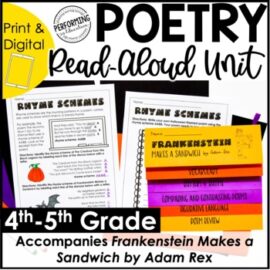
Halloween Read-Aloud Unit | Use With Frankenstein Makes a Sandwich | 4th-5th
You may also enjoy this article.
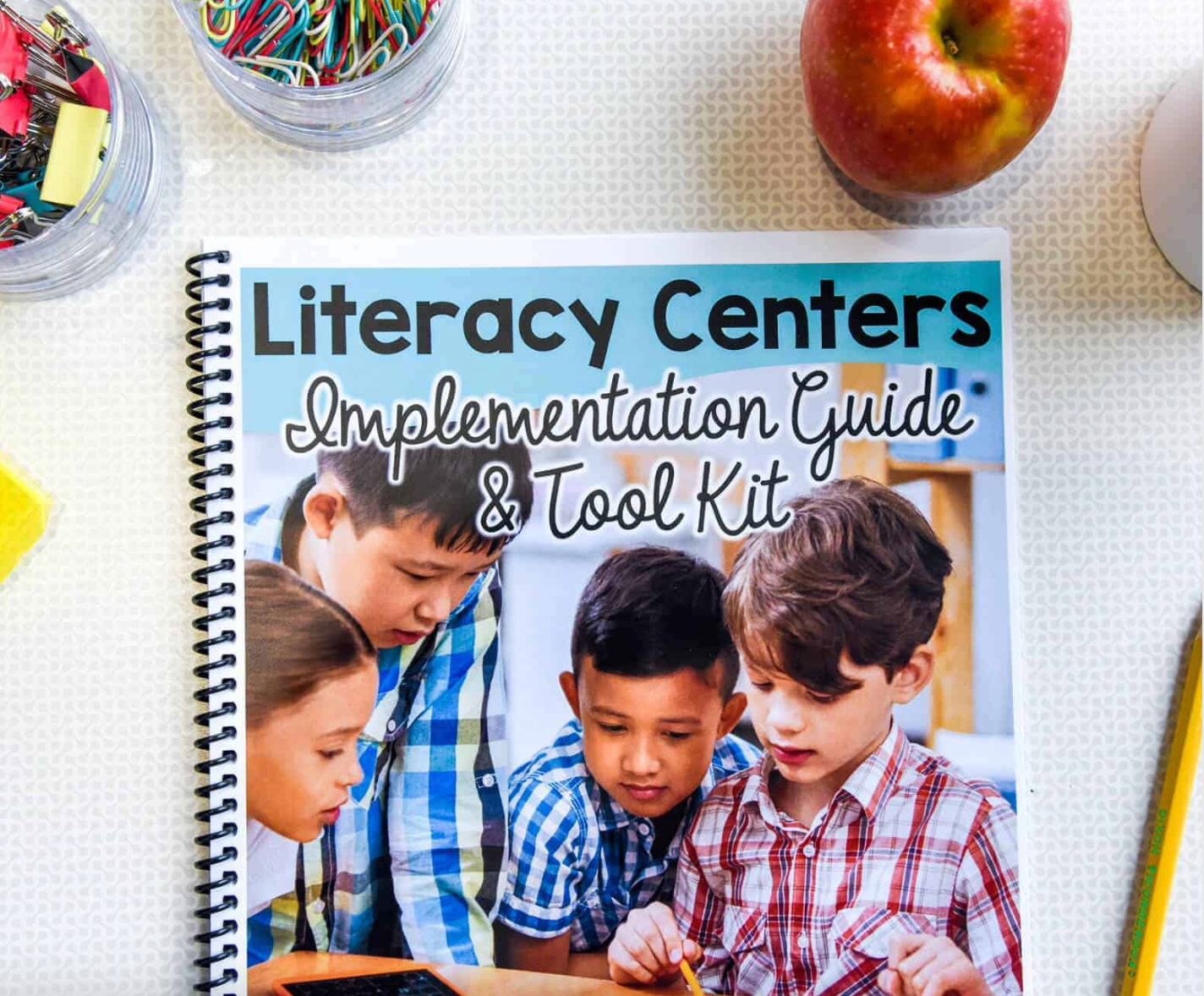
FREE Centers Guide
- Grades 6-12
- School Leaders
NEW: Classroom Clean-Up/Set-Up Email Course! 🧽
24 Figurative Language Anchor Charts That You Need Right Now
They’re the best thing since sliced bread!
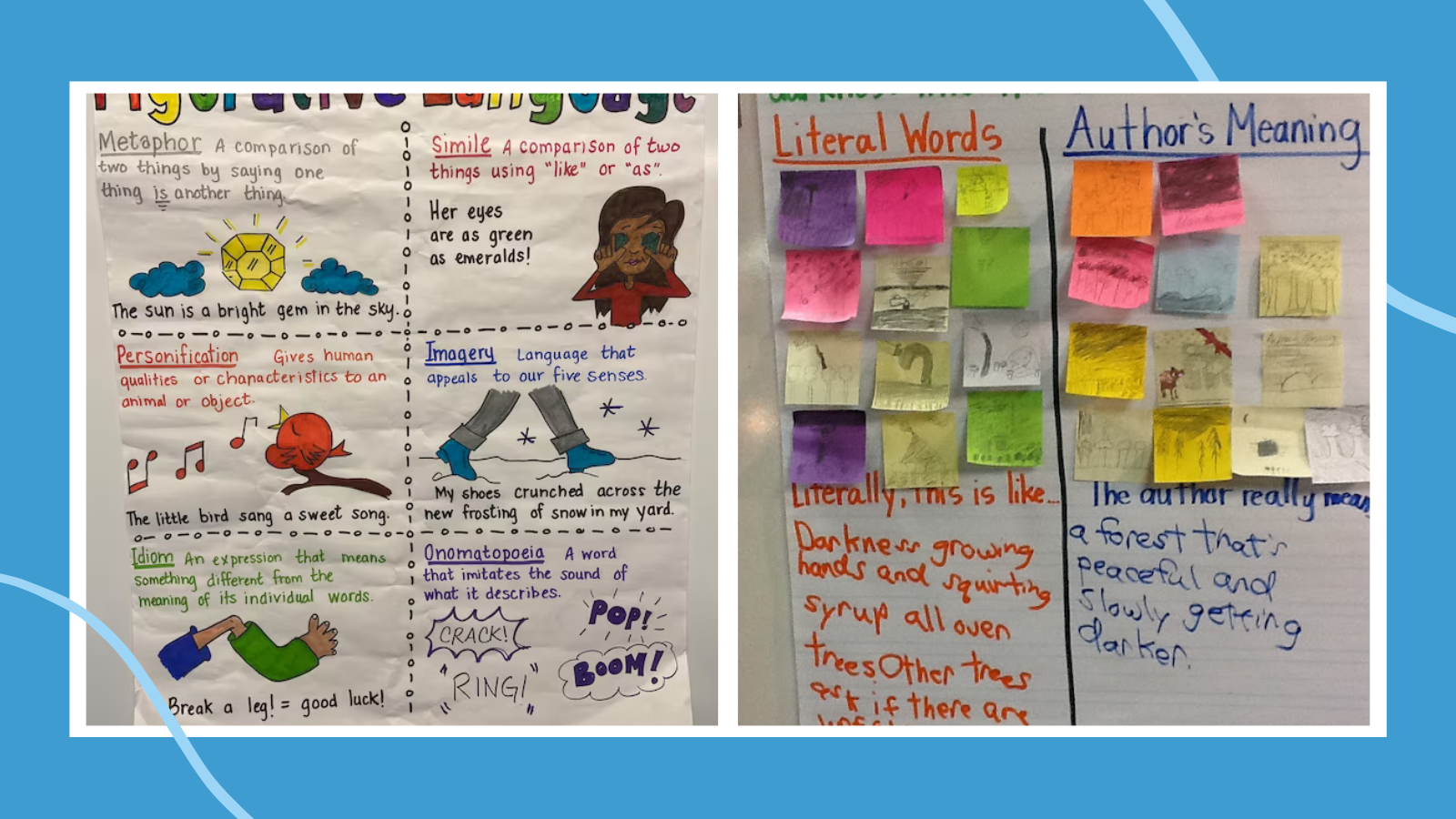
Figurative language is important for reading comprehension, and it’s fun to teach. Once students understand the difference between literal and figurative language and how authors use figurative language, it adds depth and a lot of humor to reading. These figurative language anchor charts provide the support you need to help kids with metaphors, similes, and so much more. Make a few to hang in your classroom quicker than a cheetah on the hunt!
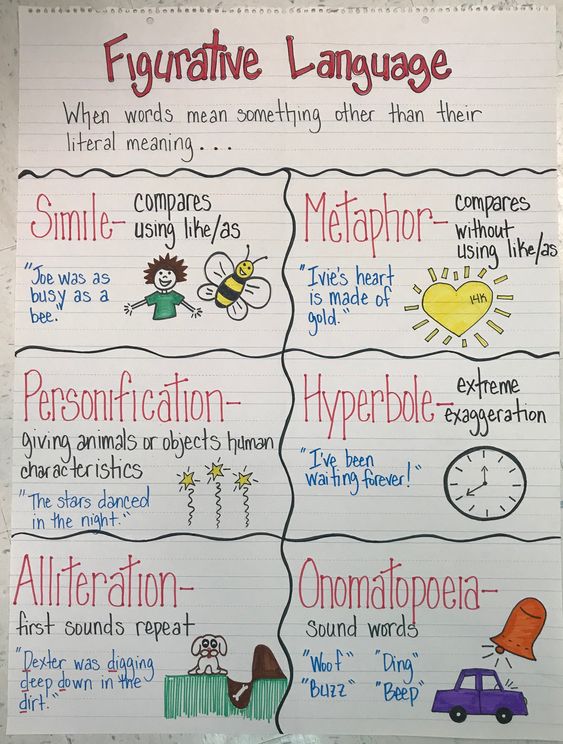
1. Figurative Language 101
This chart includes definitions and examples of some of the major types of figurative language. The pictures are terrific memory aids.
Learn more: Basic anchor chart
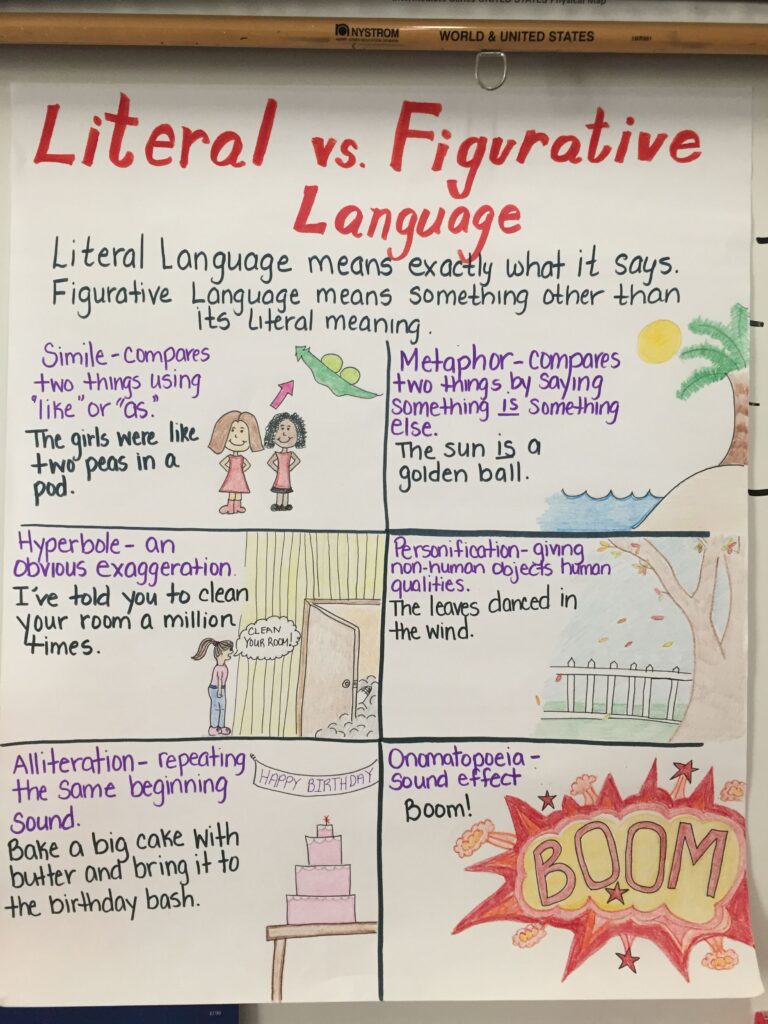
2. Literal vs. Figurative Language
Does it drive you nuts when kids use “literally” the wrong way? This chart might help! (Then again, it might not, but at least they’ll know the difference.)
Learn more: Literal vs. Figurative Language anchor chart
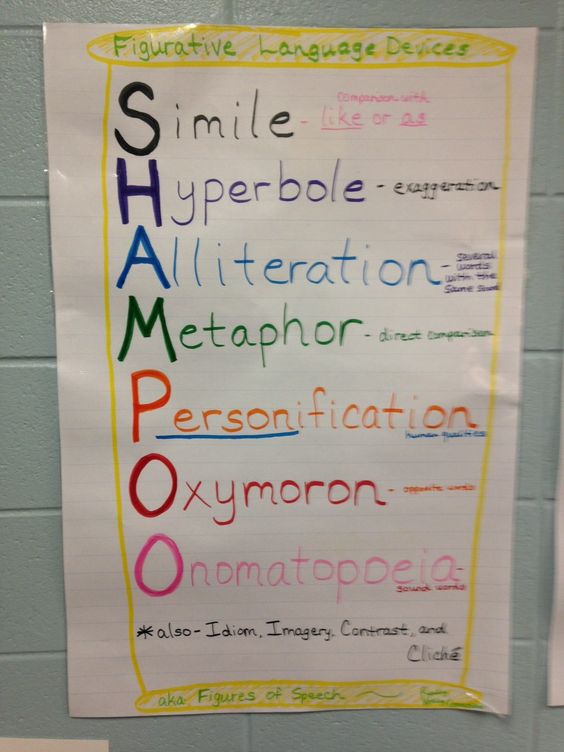
Acronyms to the rescue! This simple chart gives students an easy way to remember seven of the most common types of figurative language.
Learn more: SHAMPOO anchor chart
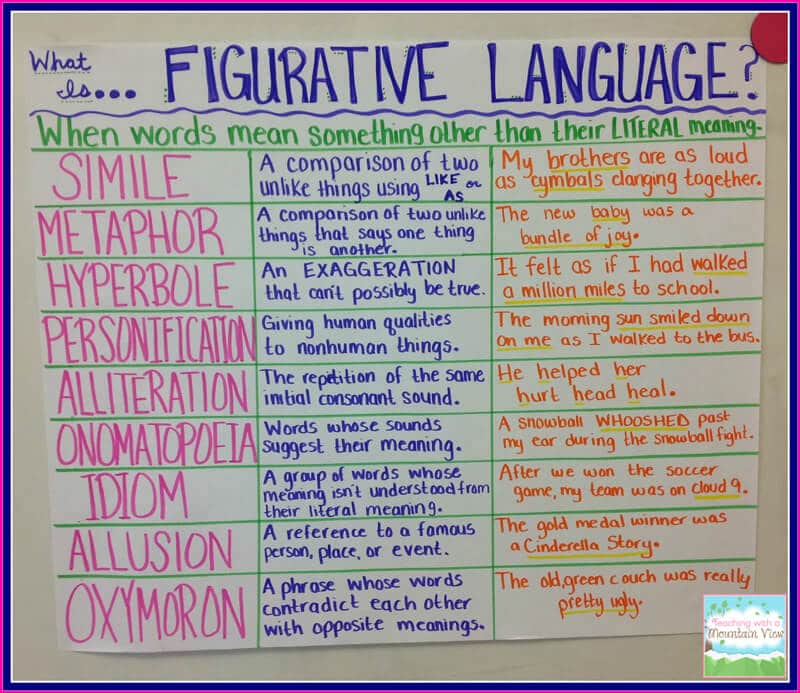
4. Definitions and examples
This comprehensive chart serves as an excellent reference for students working on tricky terms. The examples are particularly helpful.
Learn more: Table-format anchor chart
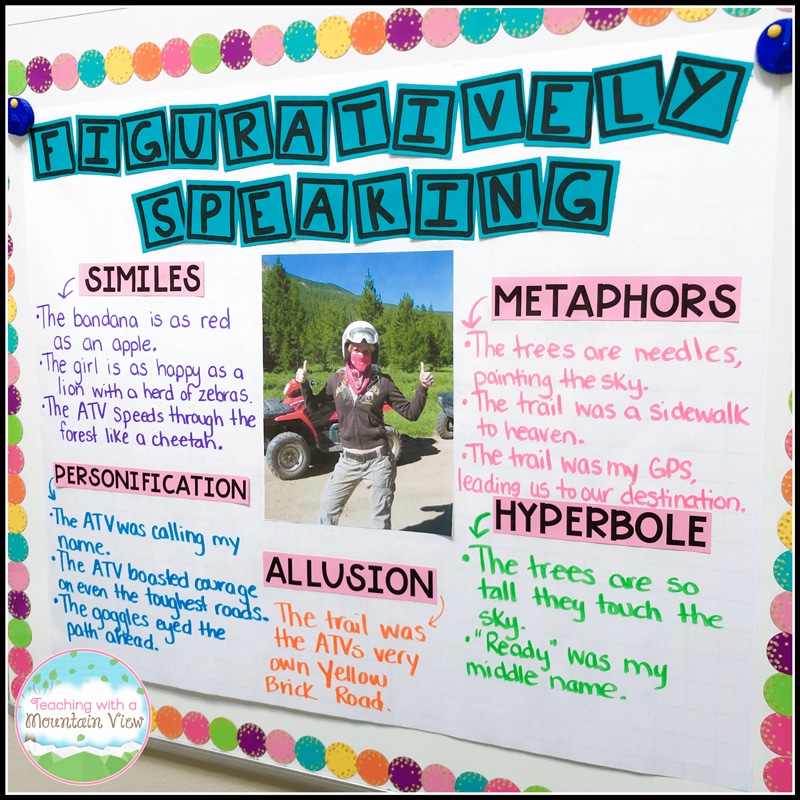
5. Figuratively Speaking
Highlight some of the most-used figurative language and provide multiple examples. Be sure to have students help you come up with the best ones to list.
Learn more: Figuratively Speaking anchor chart
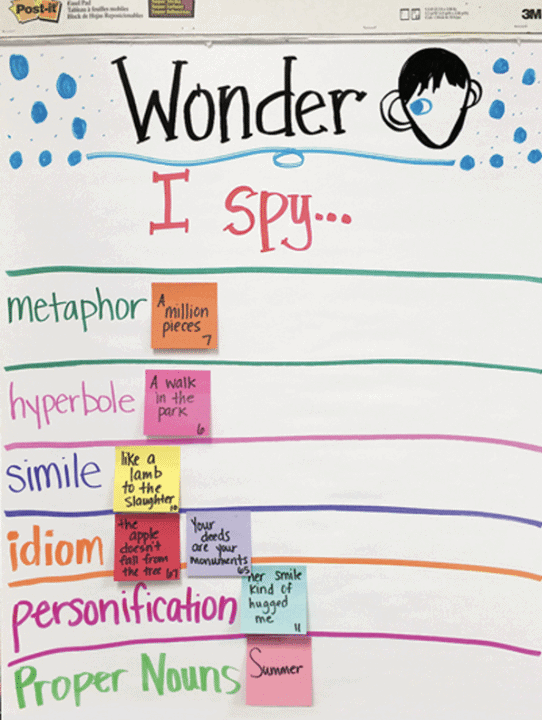
6. Build your own anchor chart
Make a blank chart you can use with any text. Students add examples using sticky notes as they read.
Learn more: Anchor chart with student examples
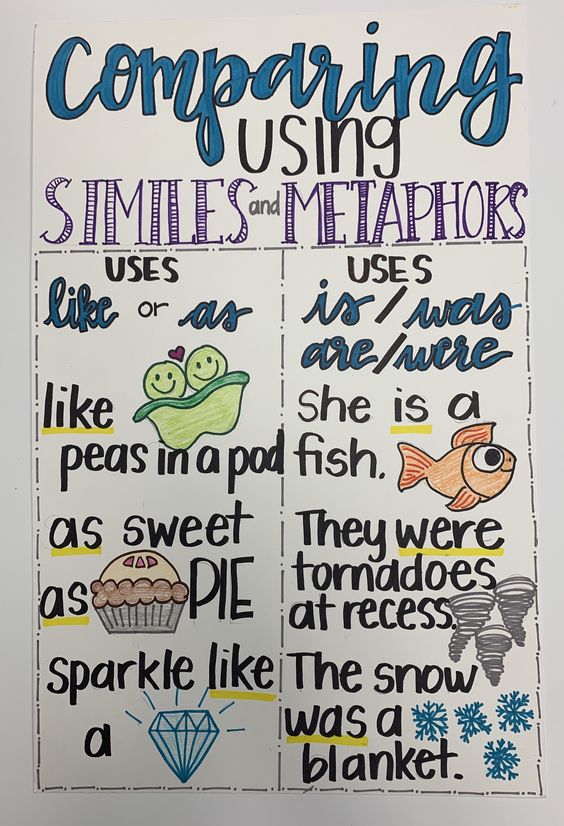
7. Compare similes and metaphors
Similes and metaphors are similar, but the difference is in the key words “as” or “like.” This chart makes that as clear as crystal.
Learn more: Anchor chart comparing metaphors and similes
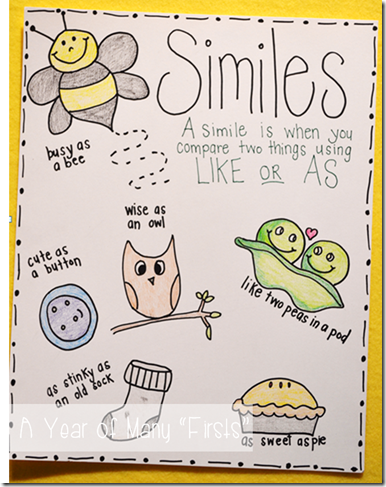
8. Simile examples
It can be a little difficult for kids to tell similes apart from metaphors. This cute-as-a-button chart gives lots of examples.
Learn more: Similes anchor chart
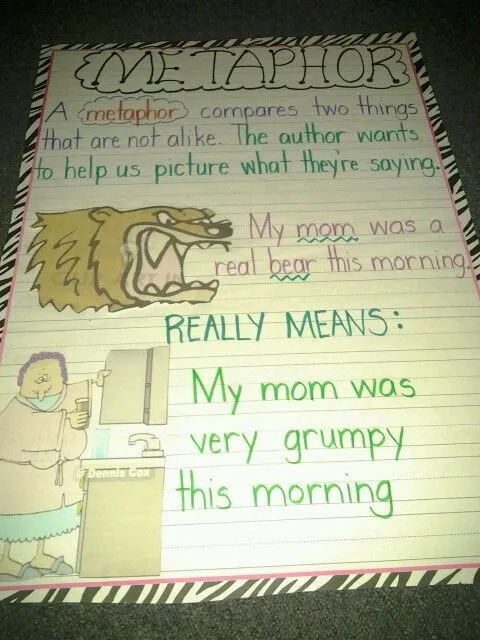
9. Make metaphors clear
This chart provides a great (and fun) example of a metaphor. Challenge students to create their own metaphors using this one for inspiration.
Learn more: Metaphor anchor chart
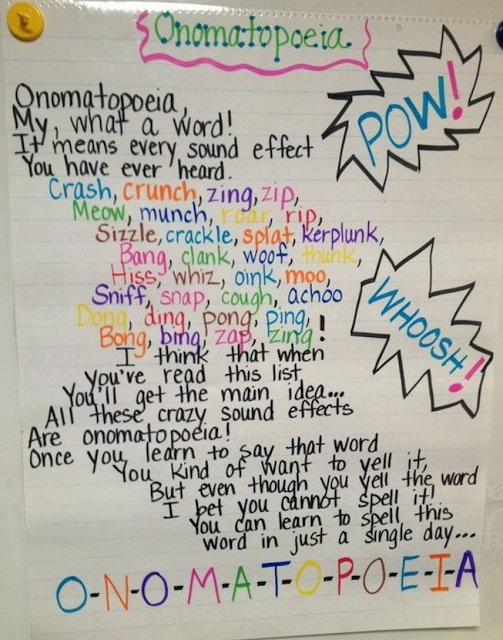
10. Onomatopoeia poem
OK, maybe they won’t all be able to spell it, but they’ll definitely remember what it means! Onomatopoeia is everyone’s favorite type of figurative language.
Learn more: Onomatopoeia poem anchor chart
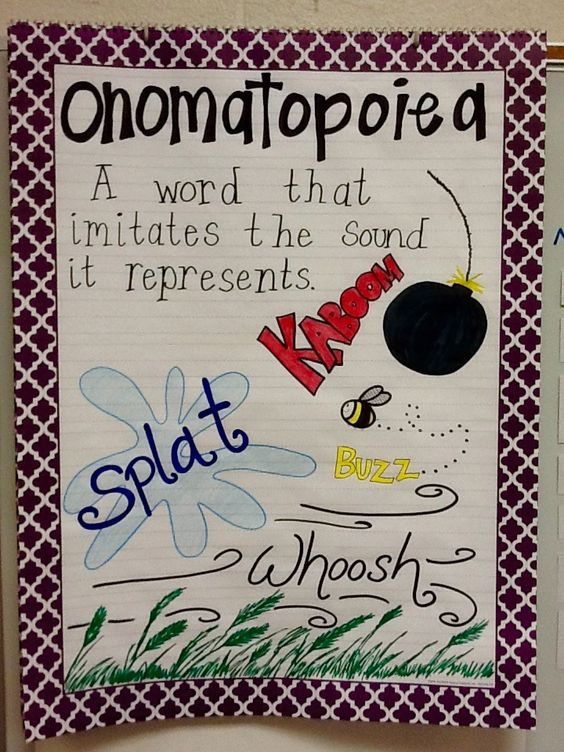
11. Onomatopoeia examples
Pow! These illustrated examples make the meaning of this figurative language term easy and clear.
Learn more: Onomatopoeia example anchor chart
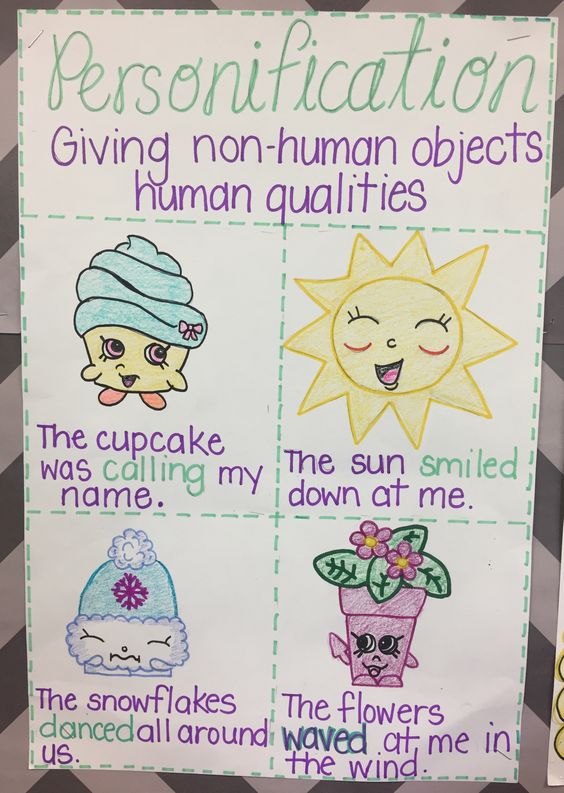
12. Make it cute
The sweet illustrations on this chart really make it come alive. Can’t draw? Print some free clip art images instead.
Learn more: Personification anchor chart
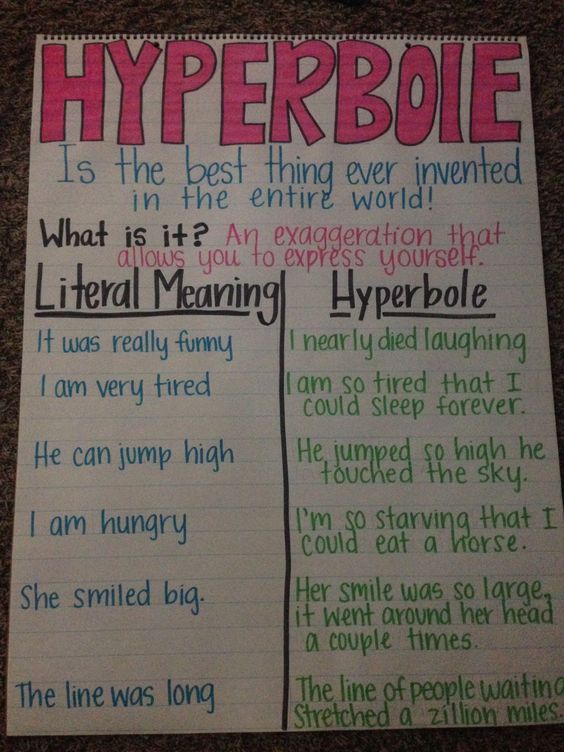
13. Hyperbole is the best!
This is one kind of figurative language that definitely comes naturally to kids, even if they don’t know its name. They’ll love coming up with the best examples in the world!
Learn more: Hyperbole anchor chart
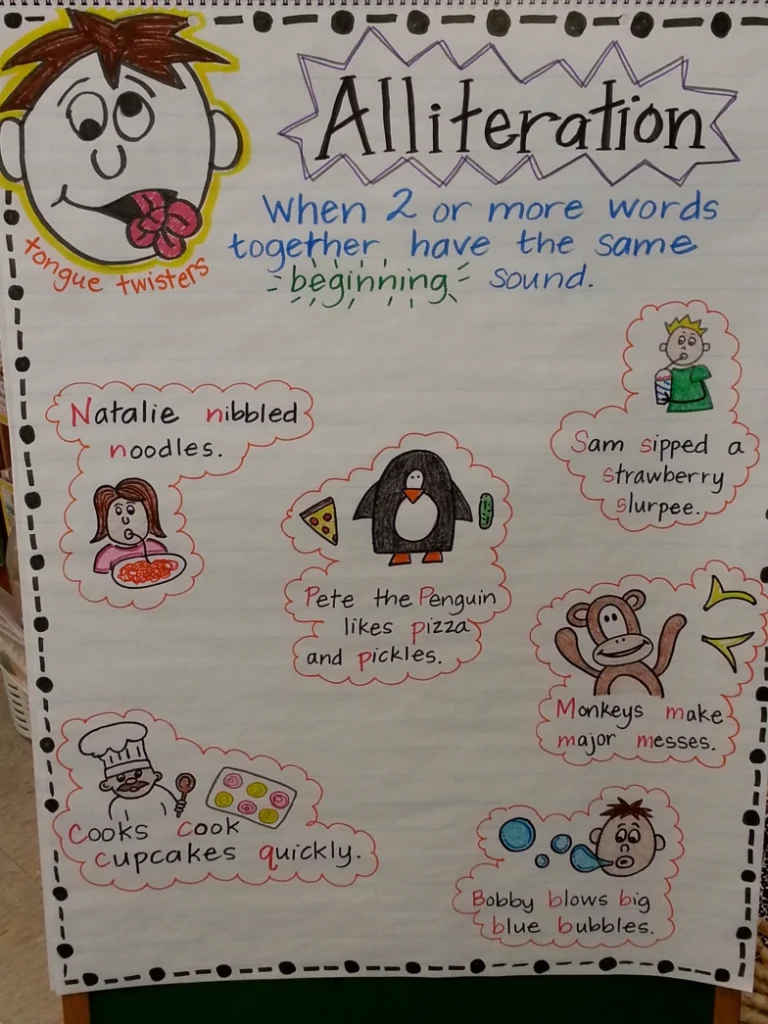
14. Alliteration tongue twisters
Looking for an amazingly awesome alliteration anchor chart? Here it is! These hilarious tongue twisters will be a big hit with kids.
Learn more: Alliteration anchor chart
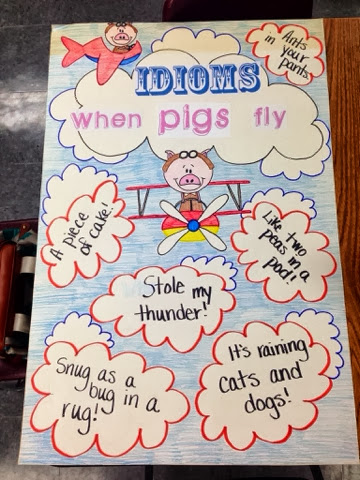
15. Explain idioms
Idioms become natural to us over time, but young students have to learn them. Use this chart, plus check out these idioms every kid should know .
Learn more: When Pigs Fly anchor chart
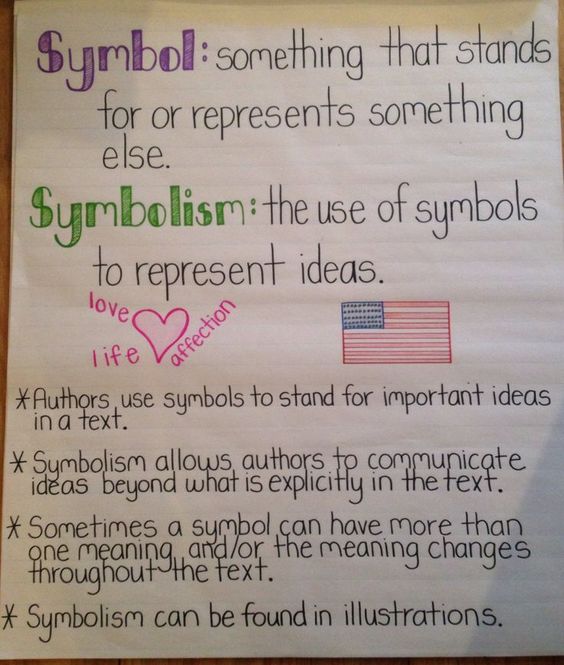
16. Symbols and symbolism
Being able to identify symbolism is an extremely important skill for students to develop as they grow older. Introduce the concept with this anchor chart.
Learn more: Symbolism anchor chart
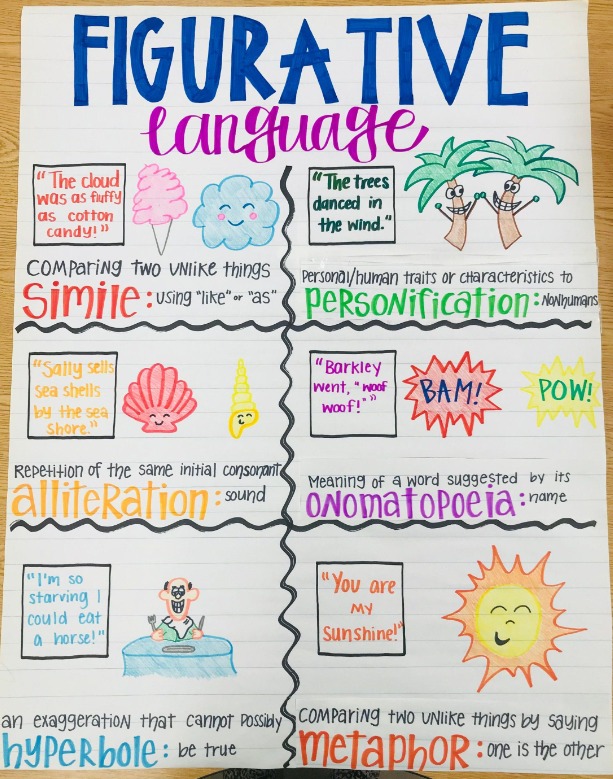
17. Use humor
Once students have mastered all the elements, create a cute anchor chart that aligns with your grade level’s humor.
Buy it: Figurative language anchor chart
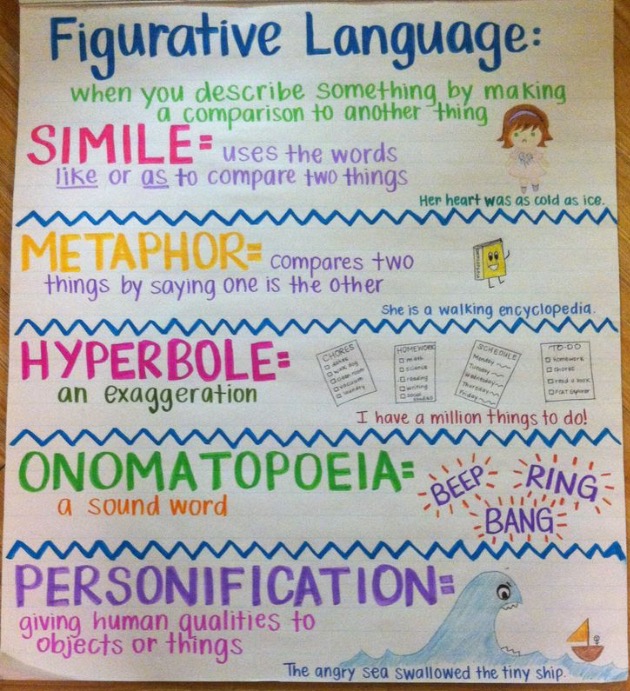
18. Keep it clear and crisp
Use a clean, crisp anchor chart to reinforce the definitions of different figurative language options.
Learn more: Figurative language anchor chart
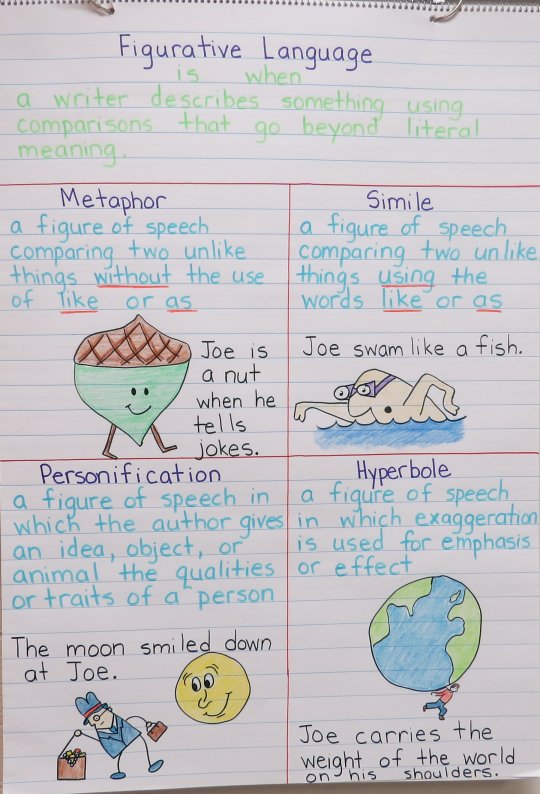
19. Create clear examples
Incorporate different colors to help organize the text so students can quickly get what they need from the anchor chart, a definition or example.
Learn more: Figurative language flip chart
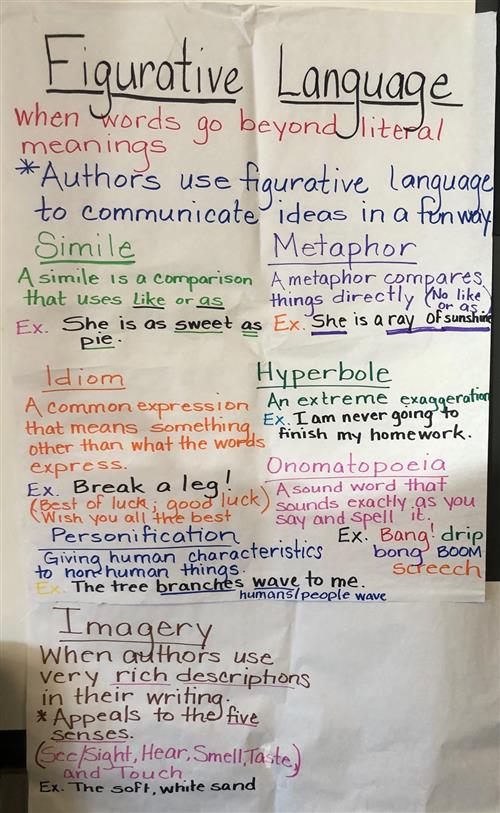
20. Don’t forget older students
Older students can handle more complex examples of figurative language and more information about why authors use figurative language.
Learn more: Complex figurative language anchor chart
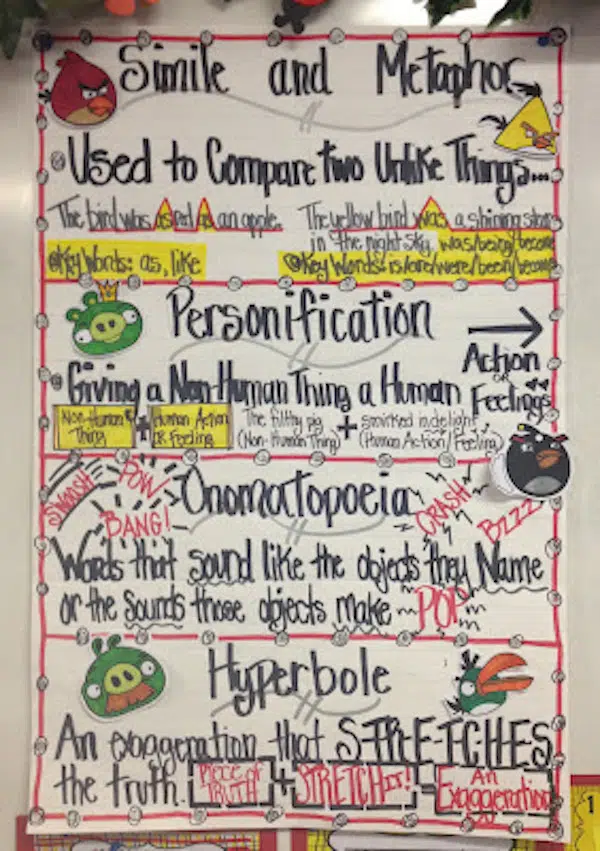
21. Bring in pop culture
If you’re looking for figurative language anchor charts that are silly and creative, try using examples from pop culture. This anchor chart features Angry Birds to help students remember each figurative language skill.
Learn more: Pop culture anchor chart
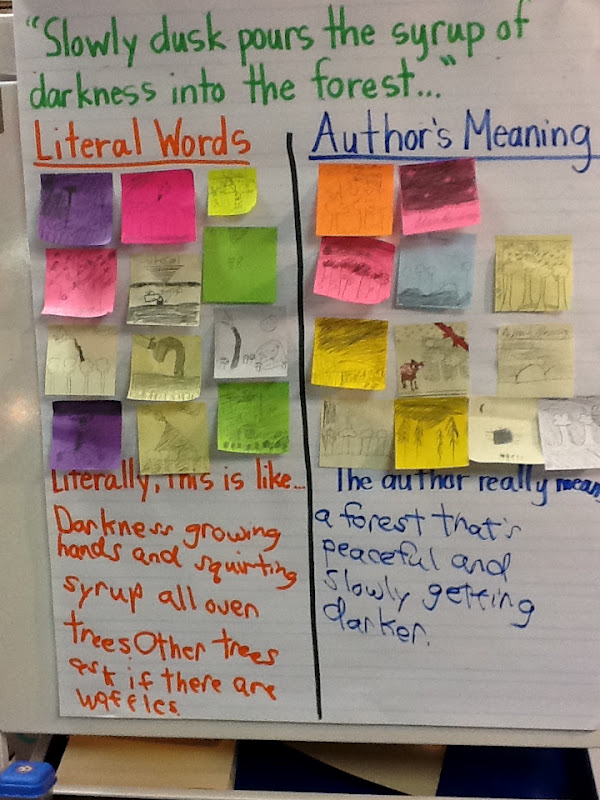
22. Engage with examples
Engage students in creating your own anchor chart, like this one where students added figurative language and what it literally means.
Learn more: Anchor chart with sticky notes
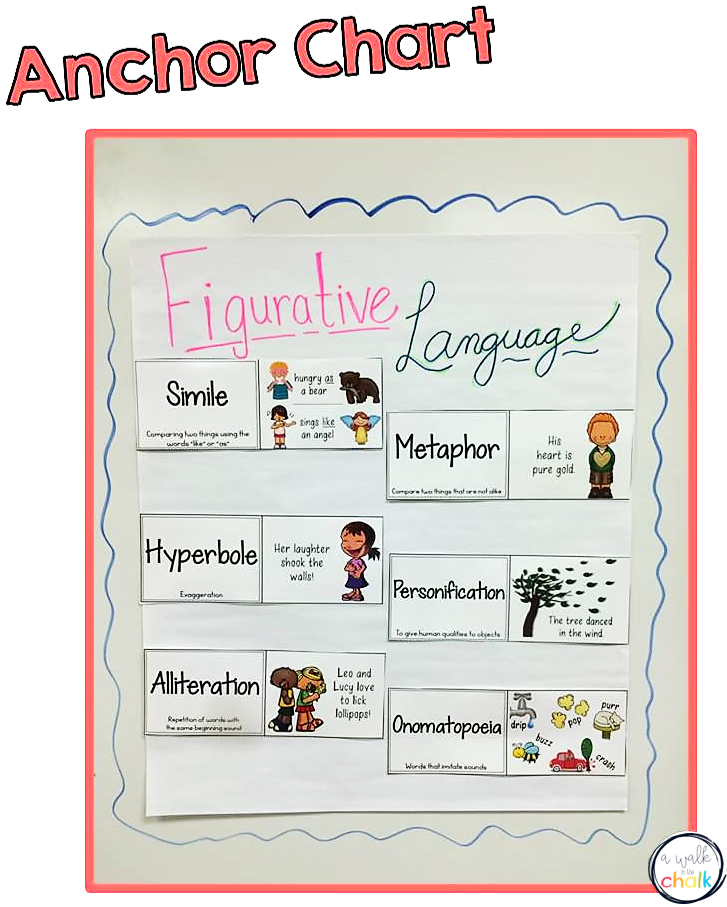
23. Support English-language learners
Students who are learning English benefit from examples that are clear and concise, with images to support language learning, like this anchor chart.
Learn more: ESL and figurative language anchor chart
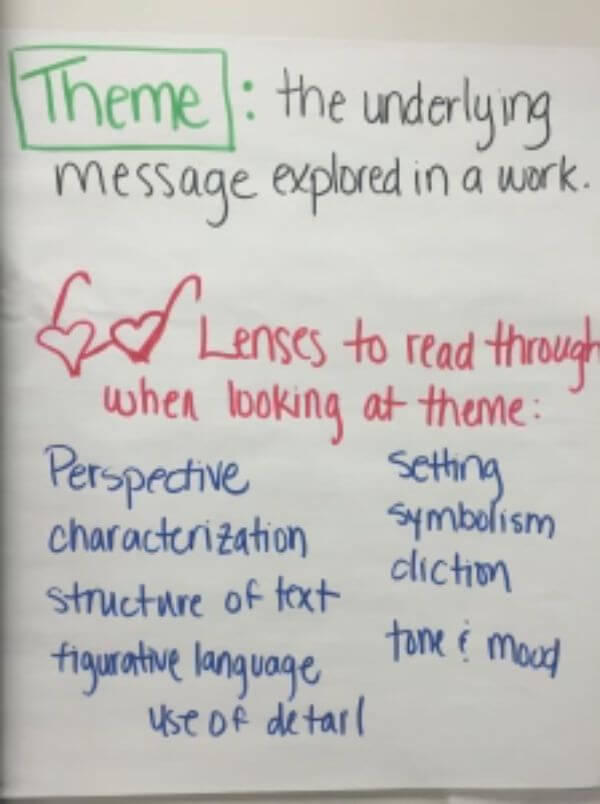
24. Connect with comprehension
Help students see when they should be thinking about figurative language, like when they are reading to understand theme.
Learn more: Theme anchor chart
Looking for more ideas like these figurative language anchor charts? Try these anchor charts that nail reading comprehension .
Plus, get all the latest teaching ideas and tips straight to your inbox when you sign up for our free newsletters .
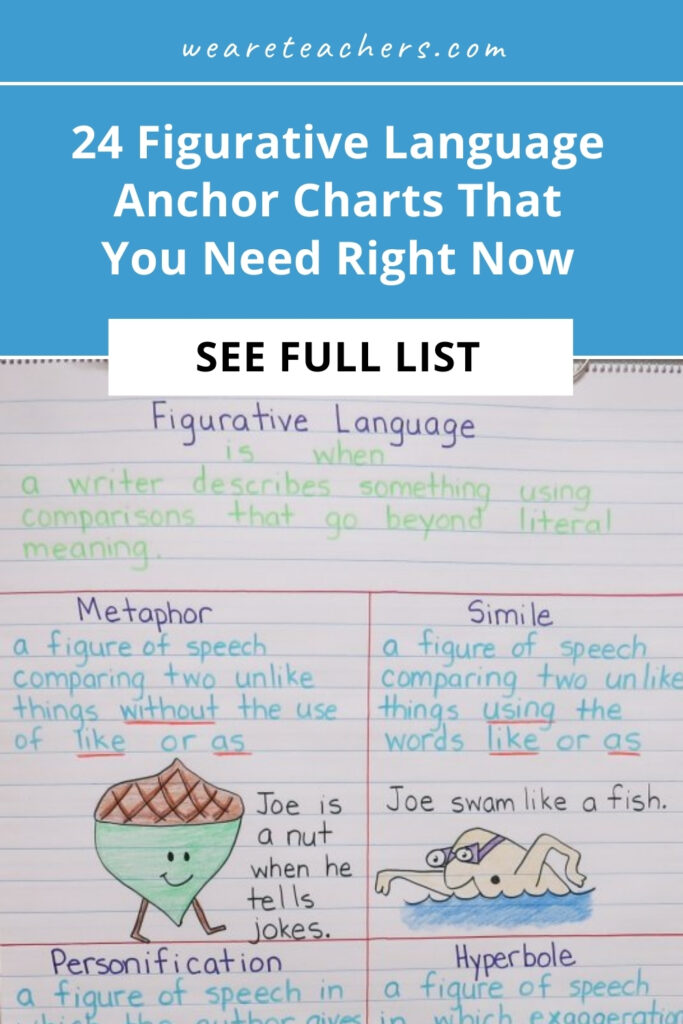
You Might Also Like
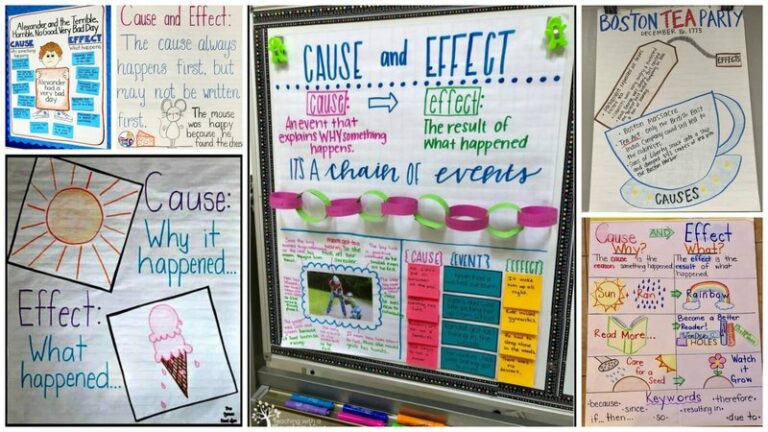
15 Cause-and-Effect Anchor Charts to Try in Your Classroom
Cause: anchor chart. Effect: lots of learning! Continue Reading
Copyright © 2024. All rights reserved. 5335 Gate Parkway, Jacksonville, FL 32256
- International
- Education Jobs
- Schools directory
- Resources Education Jobs Schools directory News Search

Persuasive Texts POSTERS BUNDLE | Opinion Writing ANCHOR CHARTS BUNDLE!
Last updated
2 June 2024
- Share through email
- Share through twitter
- Share through linkedin
- Share through facebook
- Share through pinterest
Resources included (11)

Persuasive Writing Topic Cards | Persuasive Writing Prompt Card Posters

Persuasive Texts Editing Checklist | Editing Opinion Writing ANCHOR CHART!

Persuasive Texts Revising Checklist | Revising Opinion Writing ANCHOR CHART!

Persuasive Texts Editing Poster | Editing Opinion Writing ANCHOR CHART!

Persuasive Writing Emotive Language Poster | Opinion Writing ANCHOR CHART!

Language Features Persuasive Writing ANCHOR CHART | Opinion Writing Features

Connecting Words ANCHOR CHART or Poster for Persuasive Writing | Opinion Texts

DIFFERENTIATED Mentor Text Persuasive Writing | Opinion Writing

Revising Poster for Persuasive Writing | Opinion Writing Revision ANCHOR CHART!

Structure of Persuasive Writing Poster | Opinion Writing Structural Poster

Sentence Starters Opinion Writing | Superb Starters Poster Persuasive Writing
Looking for interesting persuasive writing resources to help your students learn all about opinion writing? Then you should check out this Persuasive Writing Posters BUNDLE! Includes a variety of anchor charts to help your students learn & remember the structure and language features of persuasive texts as well as provide suggestions for creative sentence starters, emotive language and linking words to enhance their opinion writing pieces! This BUNDLE also includes self-assessment checklists for editing & revising to teach your students how to independently assess their own work!
Superb Starters - Sentence Starters Poster
Poster on the Structure of Persuasive Writing
Editing Persuasive Texts Poster
Revising Persuasive Texts Poster
Emotive Language Poster
Language Features Poster
Logical Linkers - Linking Words Poster
Editing Checklist
Revising Checklist
3 DIFFERENTIATED Mentor Texts
Tes paid licence How can I reuse this?
Your rating is required to reflect your happiness.
It's good to leave some feedback.
Something went wrong, please try again later.
This resource hasn't been reviewed yet
To ensure quality for our reviews, only customers who have purchased this resource can review it
Report this resource to let us know if it violates our terms and conditions. Our customer service team will review your report and will be in touch.
Not quite what you were looking for? Search by keyword to find the right resource:
types of writing anchor chart
All Formats
Resource types, all resource types.
- Rating Count
- Price (Ascending)
- Price (Descending)
- Most Recent
Types of writing anchor chart

Types of Writing Posters & Anchor Charts , Interactive Notebook or Bulletin Board
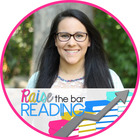
- Google Apps™
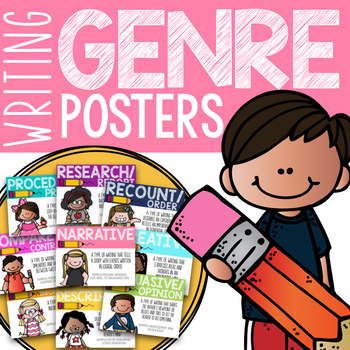
Types of Writing Anchor Charts

Types of Writing Posters and Anchor Charts for Notebooks
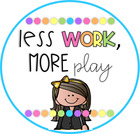
Types of Writing Anchor Charts With Sentence Stems and Writing Checklists

POETRY POSTERS Types of Poetry Reference Anchor Charts Examples Writing Guides

Interactive Types of Writing Anchor Charts and Graphic Organizers
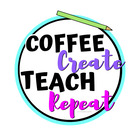
Anchor Charts : Types of Writing

Types of Persuasive Writing Poster Set/ Anchor Charts

FREEBIE Types of Writing Anchor Chart

Types of Writing Anchor Chart

Types of Writing Poster Anchor Chart

4 Types of Sentences Anchor Chart | Beginning Sentence Writing Posters
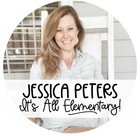
Writing : Types of Writing Anchor Chart - Digital Resource

Types of Writing , Posters, Anchor Charts , Reference Sheets

Types of Writing : Anchor Charts & Checklists Activity Pack | K-3 | Editable
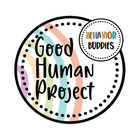
Types of Writing - Anchor Chart Poster Handout
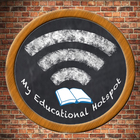
*TINY BUNDLE* Types of Writing Anchor Charts ,Checklists,&Rubrics | K-3| Editable
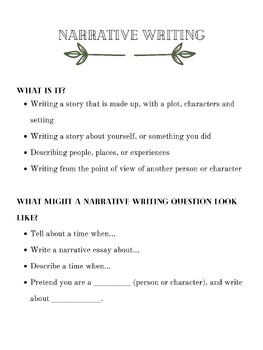
Types of Writing , Key Language Uses Anchor Charts

Types of Writing - Definitions for Anchor Chart

3 Types of Writing Anchor Chart

Types of Sentences & Writing Complete Sentences w/ Capitals & Punctuation

Paraphrasing Practice Activity - Paraphrase Task Cards - Anchor Chart - Digital

- Easel Activity
- We're hiring
- Help & FAQ
- Privacy policy
- Student privacy
- Terms of service
- Tell us what you think

IMAGES
VIDEO
COMMENTS
Vocabulary Anchor Charts; This type of chart focuses on important words in a subject. It usually has pictures, meanings, and details to help students understand and use the words in their learning and when talking about school stuff. ... Typically, this happens when introducing a topic, explaining an idea, or modelling something (like writing ...
Posting anchor charts keeps current learning accessible and helps your students to make connections as their understanding grows. Teach writing with 25 of our favorite anchor charts for the writing process. Keep the charts up-to-date and they'll serve as a living reference in your classroom and will inspire a culture of writing.
An anchor chart is a tool used to support instruction (i.e., "anchor" the learning for students). As you teach a lesson, you create a chart, together with your students, that captures the most important content and relevant strategies. Anchor charts build a culture of literacy in the classroom by making thinking—both the teacher's and ...
28. Show, Don't Tell. "Show, don't tell" is a cardinal rule of writing. This anchor chart, best for upper elementary writers, can be used to strengthen scenes in fiction and narrative nonfiction works. Build out this chart for middle school writers with additional ideas and more complex emotions.
2. Instructional Writing Anchor Chart. The criteria for writing clear instructions can be very handily displayed as an anchor chart. When writing a set of instructions, students can refer to the chart to help organize their writing. The same chart will also serve as a checklist for self-assessment at the end. An instructional writing anchor ...
Some anchor charts are interactive, meaning that students help to fill them in as a part of the lesson by writing directly on the chart or using post-it notes. This can be a great tool for formatively assessing student understanding during instruction. ... The 4 Most Popular Types of Anchor Charts . While there are lots of different kinds of ...
There are many different ways to improve your anchor charts. Below are three ways you can elevate your anchor charts. 1. Add visuals: One way to raise the level of your charts and support your learners is to add visuals. This is essential for our primary readers and writers to be more independent when using charts.
An anchor chart is there to help them with writing consistency and ensure they follow the format they're given. The end goal is for students not to struggle with different types of writing even when they're not using anchor charts. Writing anchor chart examples include: Figurative language charts; Opinion writing charts; Informational ...
To make an anchor chart, you first need to gather materials. This will include chart paper and markers. Next, you need to plan your content around a key lesson or concept you want your students to remember. Choose a layout that clearly and visually organizes the information, such as bullet points, diagrams, or mind maps.
6-8 · All Freebies. This handy anchor chart reminds students of the purposes of the four types of writing: narrative, expository, persuasive, and descriptive. The chart includes a definition of each type of writing and is a great addition to writer's notebooks or bulletin boards. Make sure to use a home email address.
Types of Anchor Charts. There are three common types of anchor charts: procedural, process, and strategy. The hallmark of an organized classroom is how well the students follow the classroom routines. ... Most classrooms have a process anchor chart on the steps for writing a good extended response. Standard-sized copies of process anchor charts ...
Narrative Writing is my personal favorite type of writing to teach. The creativity and possibilities that come with this type of writing are endless! Today, we are going to take a look at 7 strong anchor charts for teaching narrative writing. Anchor charts are always a great tool for introducing or even revisiting a skill.
Trail of Tears Informative Writing Unit By Life Beyond the Gradebook. This Trail of Tears Informative Writing Unit is a whole resource pack. It is aimed at grades 3 - 6. The pack contains a poster that you can use as an anchor chart. The aim of the unit is to teach the students the process of informational writing.
Use anchor charts to show examples of some of different text features readers may encounter. For example, photographs, charts, graphs, captions, etc. This chart addresses why text features are an important part of nonfiction texts: SOURCE: Second Grade Style. And this one, for upper elementary students, goes into greater detail about each feature.
This way, you can rest assured you'll enrich your classes with high-quality anchor charts made by people who know what it takes to teach students different types of writing. Different ways to use anchor charts to teach opinion writing. Let's look at how anchor charts can be used differently to highlight opinion writing.
It is a common teaching practice for teachers to use elaboration anchor charts to show students where and how they should elaborate on their writing.. I have always enjoyed using these elaboration anchor charts to teach writing to my students about the different types of elaboration.. However, I run into the problem that many of them need to remember to refer to them while writing an essay ...
This writing anchor chart by Karen Jones is lovely because it lays things out, step by step, when it comes to the writing process for our little kindergarten babies. The illustrations she provides as examples are prefect, too! This anchor chart by Rachel's Reflections is a great description of what a personal narrative, or small moment, will ...
Description. This anchor chart provides basic definitions for narrative, expository, persuasive, and descriptive writing and supports Common Core writing activities. It works well as an addition to a writer's notebook or as a poster to hang on the wall or bulletin board. Your questions are welcome, and your feedback is appreciated!
These ready to use handouts includes a prompts from a past exams and breaks each down by highlighting its similarities to other prompts.This Bundle includes a sample prompt for each of the three essay types on the exam: the Poetry Prompt, the Prose Prompt and the Literary Argument. These are anchor charts.
Types of Writing Anchor Charts. Created by. VeryPerryTeaching. This includes six anchor charts for the different types of writing :-Making Lists-Friendly Letters-Personal Narratives-Fictional Narratives-Opinion Writing -Informational WritingThere is a colored version and a black and white version to choose from.
Doing it this way makes it a lot easier for students to be able to work with various types of poetry and how to identify them. 3. Do a Collaborative Poem. Work together with students as they start to write poems. We want to begin together so they know the process and how to use the rules.
These figurative language anchor charts provide the support you need to help kids with metaphors, similes, and so much more. Make a few to hang in your classroom quicker than a cheetah on the hunt! Pinterest. 1. Figurative Language 101. This chart includes definitions and examples of some of the major types of figurative language.
This is a set of 5 handouts/ anchor charts of strategies & structures for the parts of an argument essay:Introduction Strategies (16 strategies divided into 3 categories/types based on purpose & function -- logical appeal, emotional appeal, appeal to credibility)Thesis Statement Structures(4 types of thesis statements -- open, closed, counter argument, position -- w/ definitions & ...
Includes a variety of anchor charts to help your students learn & remember the structure and language features of persuasive texts as well as provide suggestions for creative sentence starters, emotive language and linking words to enhance their opinion writing pieces! This BUNDLE also includes self-assessment checklists for editing & revising ...
Types of Writing Anchor Charts. Created by. VeryPerryTeaching. This includes six anchor charts for the different types of writing :-Making Lists-Friendly Letters-Personal Narratives-Fictional Narratives-Opinion Writing -Informational WritingThere is a colored version and a black and white version to choose from.